This is the order of insects (Diptera) that includes mosquitos, gnats, yellow flies, fruit flies- all our favorite pestilence. Like all animals, they evolved by finding a niche that allowed them to survive as best they could. When I started photographing insects in my yard, though, I found flies to be a more diverse lot than I had thought. Many have found niches that actually benefit humans. So, they’re not all bad (from a human point of view).
What I’m going to highlight on this page are the many flies I see in my north Florida yard (also a few others). It’s not a list of every fly in the panhandle; instead, this is a list of common species you may encounter in your own yard or while out and about. Flies are predators, decomposers, pollinators, and parasites. You may find that, like me, you’ll like a few species much more than others.
I’ve broken this list up by suborder, then family. The order in which I’m presenting them is based on, honestly, the ones I like best. These are some of the superstars in my yard. Again, that’s my human point of view. There is a benefit beyond what any individual insect provides, and that’s diversity. Here we see many different animals filling many different niches, each an individual piece of a complex backyard food web.
Brachyceran Flies
A suborder of Diptera (flies) containing 120 families.
Syrphid Flies, aka Hoverflies (Syrphidae)
Here’s a family of insects that provide two useful services in the garden.
Adult hoverflies are pollinators. You may notice an insect fly onto a flower, leaning in to see what looks at first to be a small bee. Hoverflies mimic bees and wasps, and can be kind of ornate.
Then there’s syrphid larvae. Hoverflies first came to my attention when I saw a larva eating aphids on a milkweed plant. It had picked up one of the little orange milkweed aphids and was shaking it back and forth. Behind it I could see little white “aphid skeletons,” a trail of death and destruction.
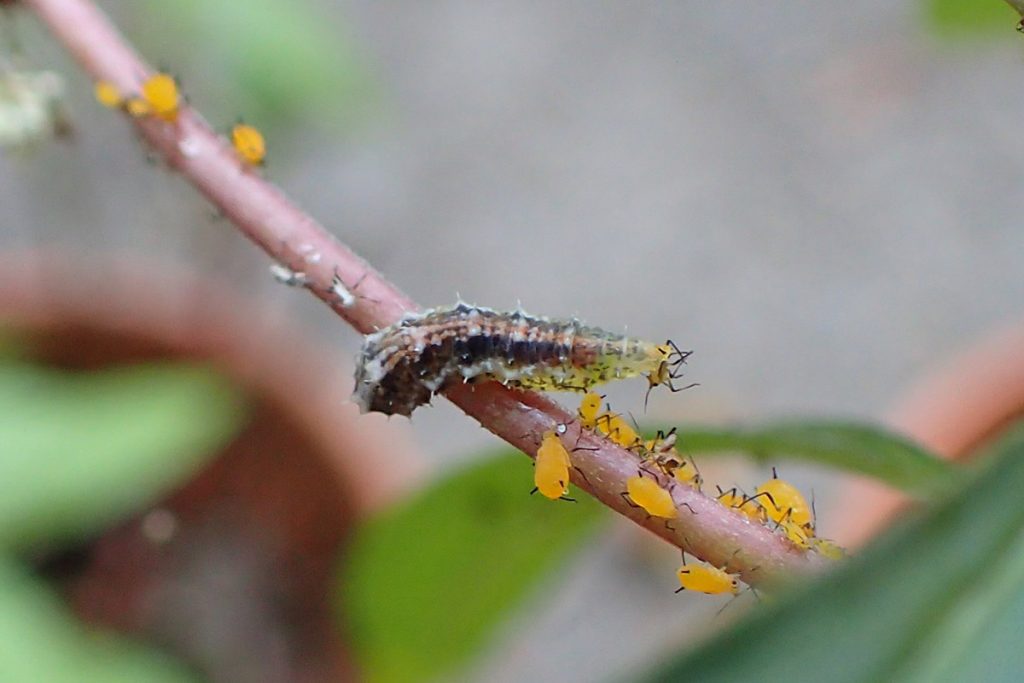
Since then, I’ve noticed a couple of different species of syrphid larvae attacking aphids on different plants. I’ve even seen adults hover next to an infested plant, and go into to press their abdomens onto the plants and lay eggs.
By including plenty of flowers, especially some of the smaller ones they like, they’ll be in your yard noticing those aphids feeding on your plants.
Oblique stripetail (Allograpta obliqua)
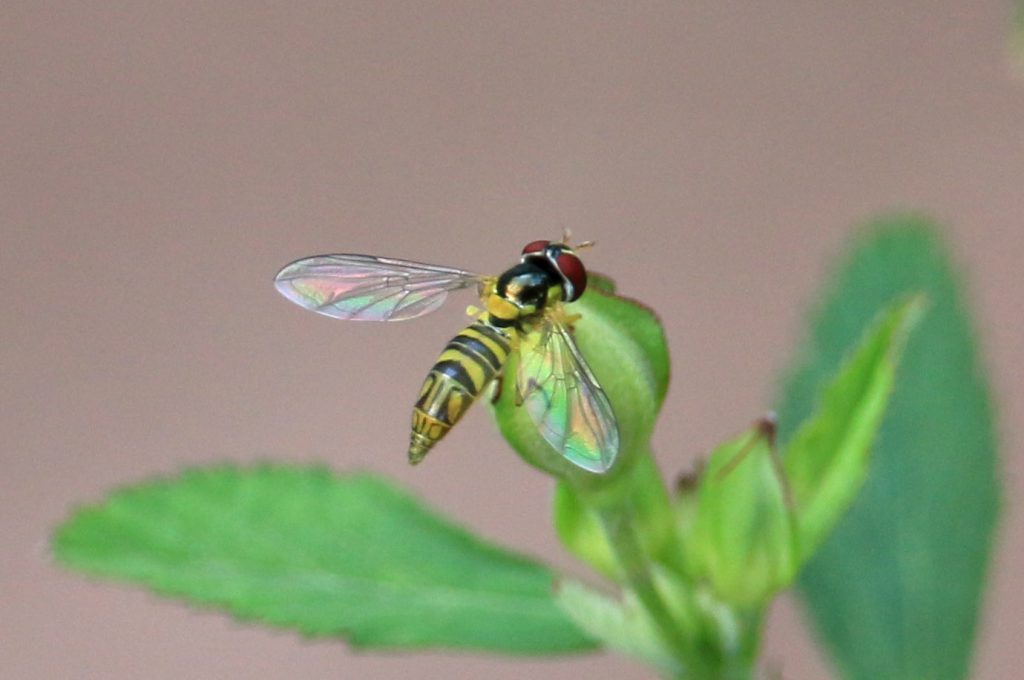
Below is a larva from this genus of hoverflies. I uploaded the photos into iNaturalist, thinking it was a caterpillar eating a pepper plant. I also photographed aphids on the plant. It turns out this was a different species of syrphid larva than I’d been seeing on our milkweed. Within a week, there were no more aphids on that plant.
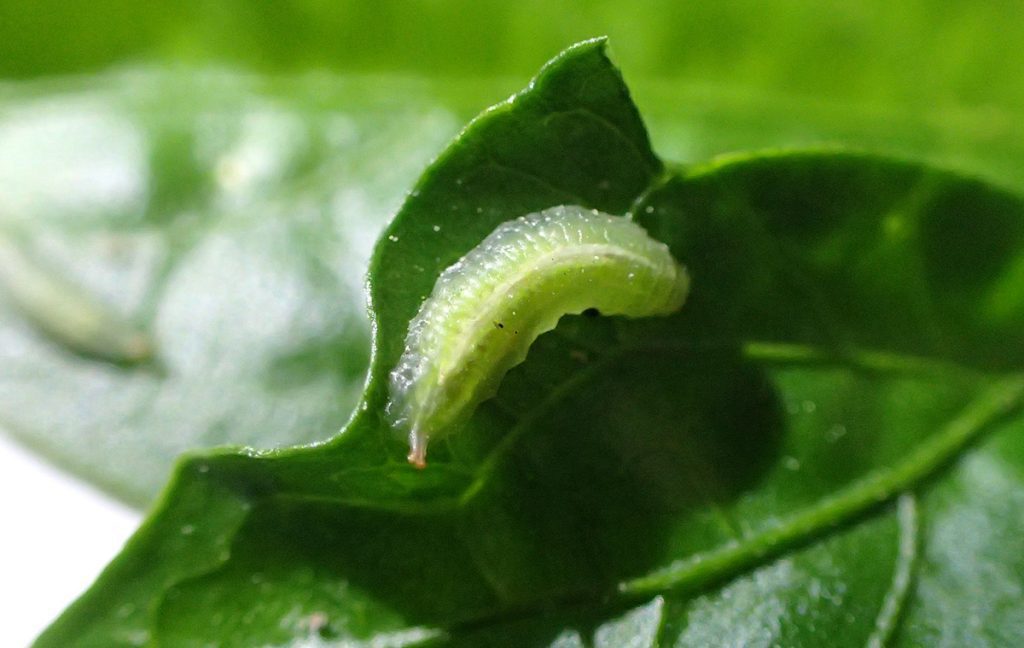
Dusky-winged hoverfly (Ocyptamus fuscipennis)
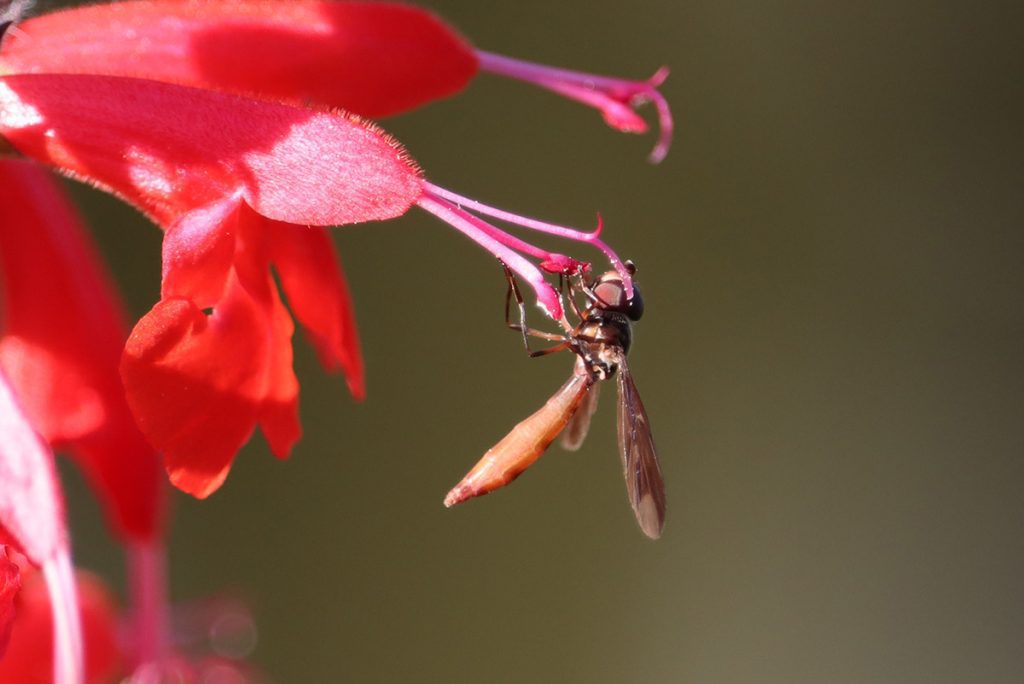
This is the hoverfly I notice most in the yard. Looking it up on bugguide.net, I see that most likely these are the syrphid larvae I always see on our milkweed.
Eupeodes americanus complex
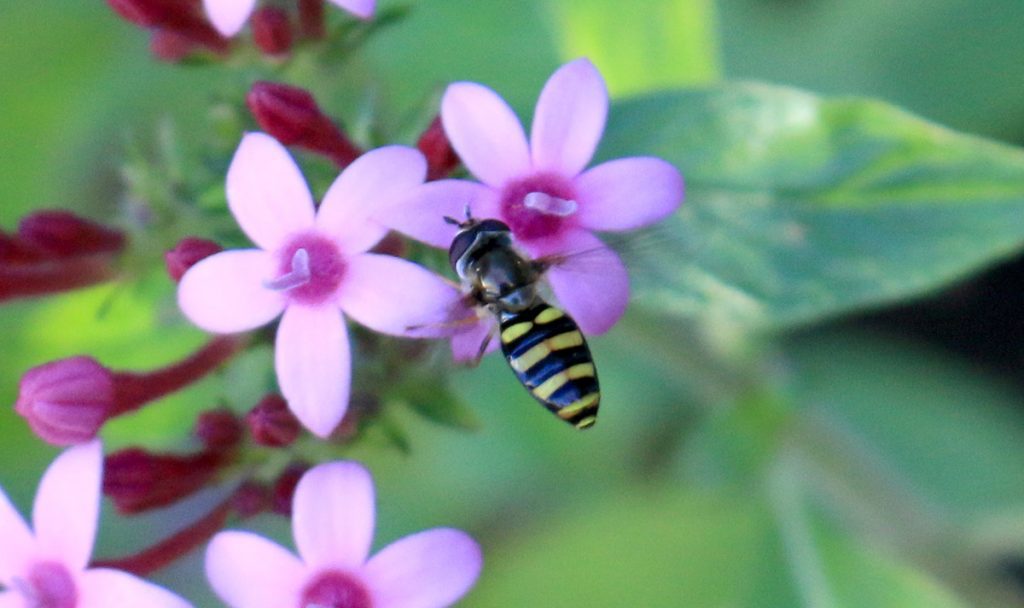
Margined calligrapher (Toxomerus marginatus)
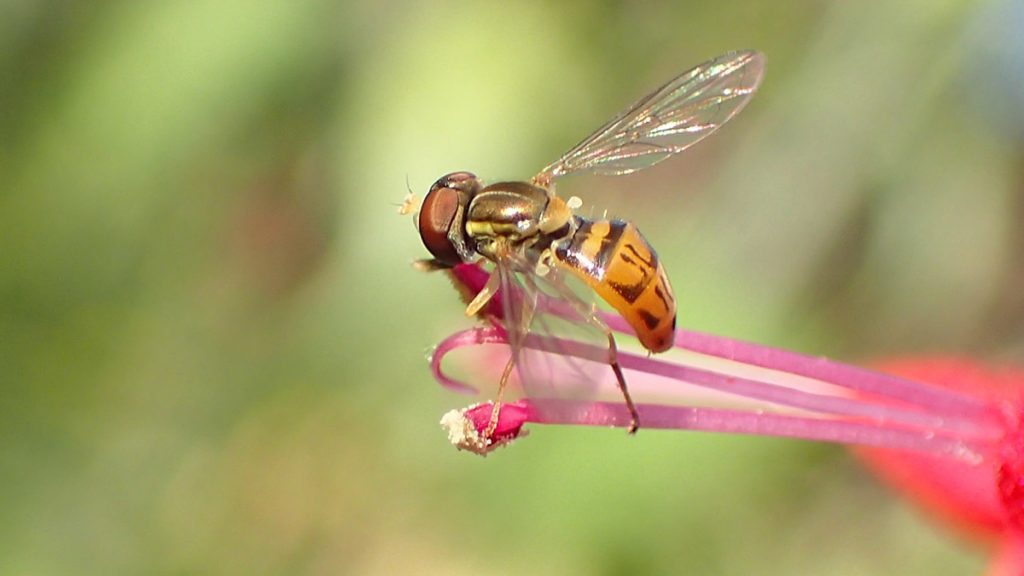
Scarlet sage attracts multiple species of hoverfly, along with bees, butterflies, and hummingbirds. This is one of four hoverflies in the Toxomerus genus I’ve photographed in Tallahassee.
Thin-lined calligrapher (Toxomerus boscii)
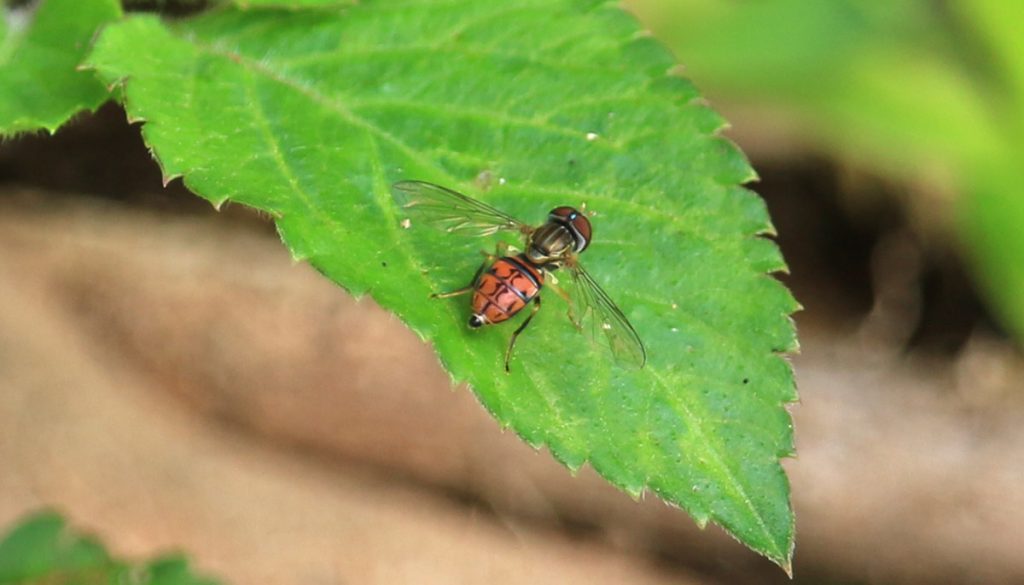
Eastern Calligrapher (Toxomerus geminatus)
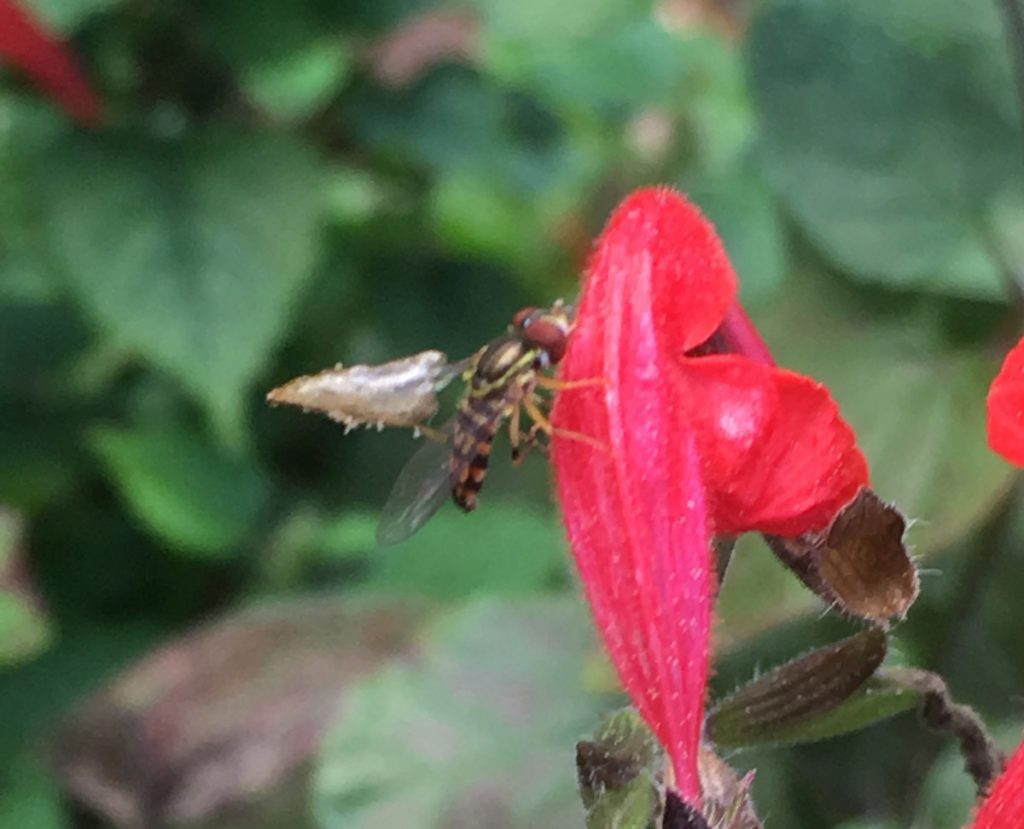
Maize Calligrapher (Toxomerus politus)
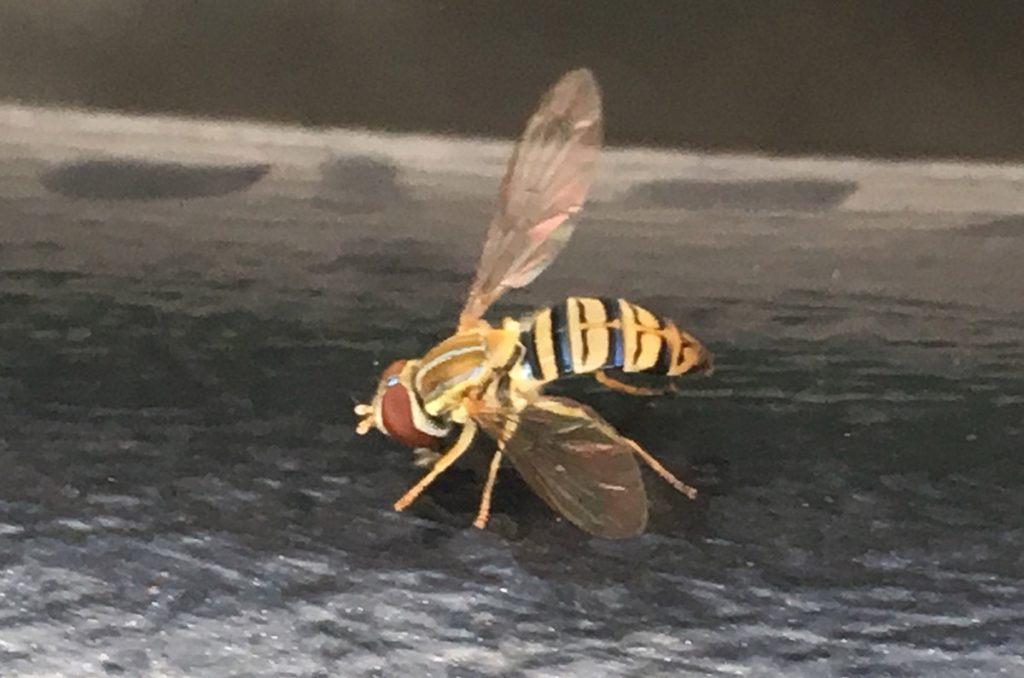
This was maybe the last place I expected to find a hoverfly. We went to meet another family at Proof when I looked down and saw this Maize calligrapher on our table.
Carolinian elegant (Meromacrus acutus)
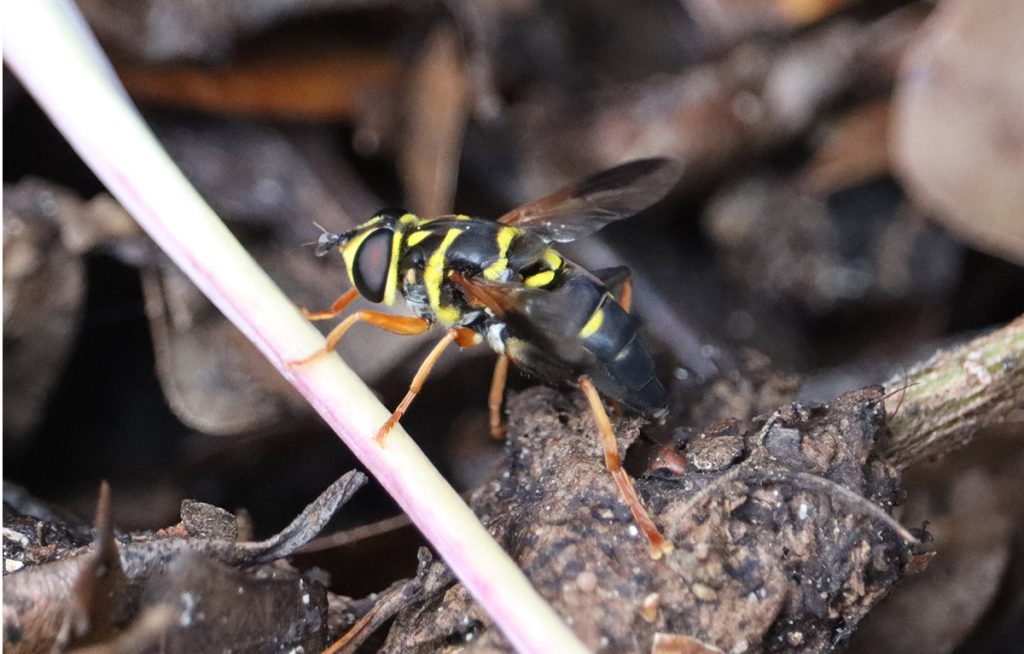
A friend of mine sent me a photo of this species of hoverfly, which was hanging around his compost bin (I’m that guy who has friends who send him photos of insects to ID). Shortly after, I was surprised to find the same species in our compost. After a little bit of Google searching, I found several instances of people saying they found these insects near compost, even if I couldn’t find a page that said definitively that their larvae eat compost (or maybe they eat the other insects that eat compost, such as black soldier fly larvae).
Northern Plushback (Palpada vinetorum)
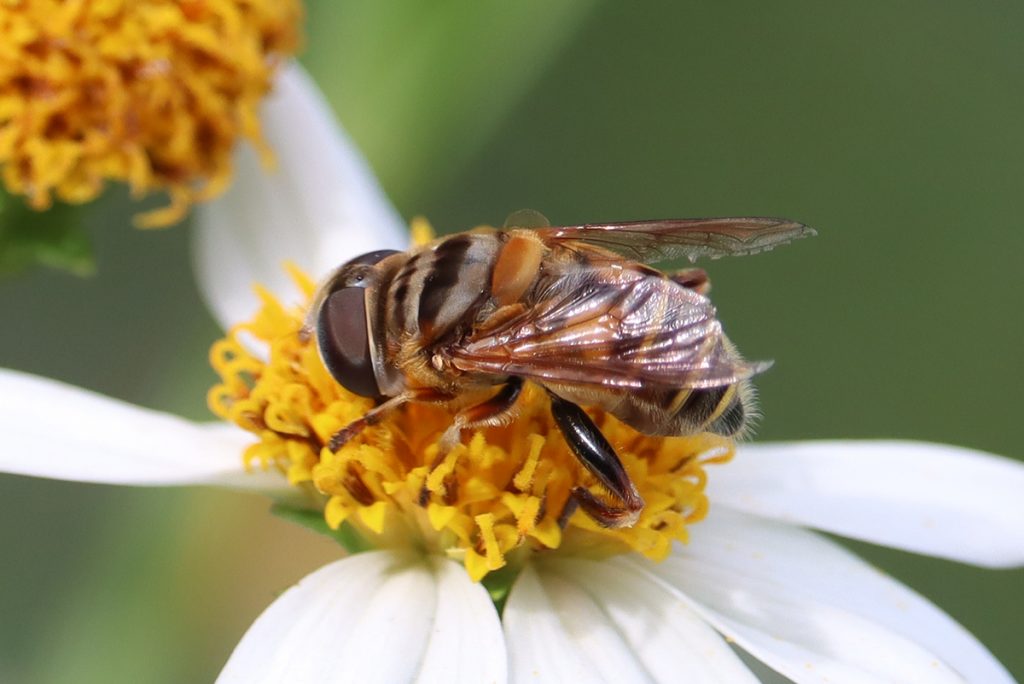
Tropical plushback (Palpada furcata)
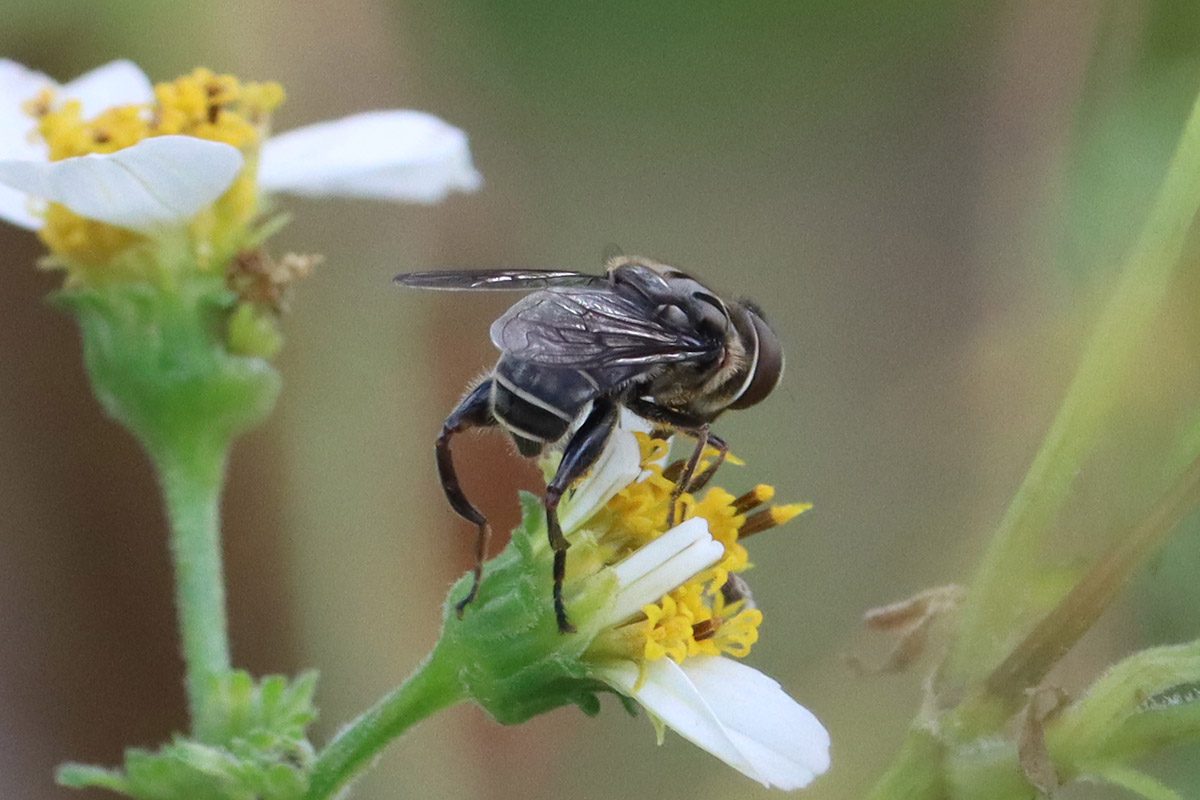
Black-shouldered Drone Fly (Eristalis dimidiata)
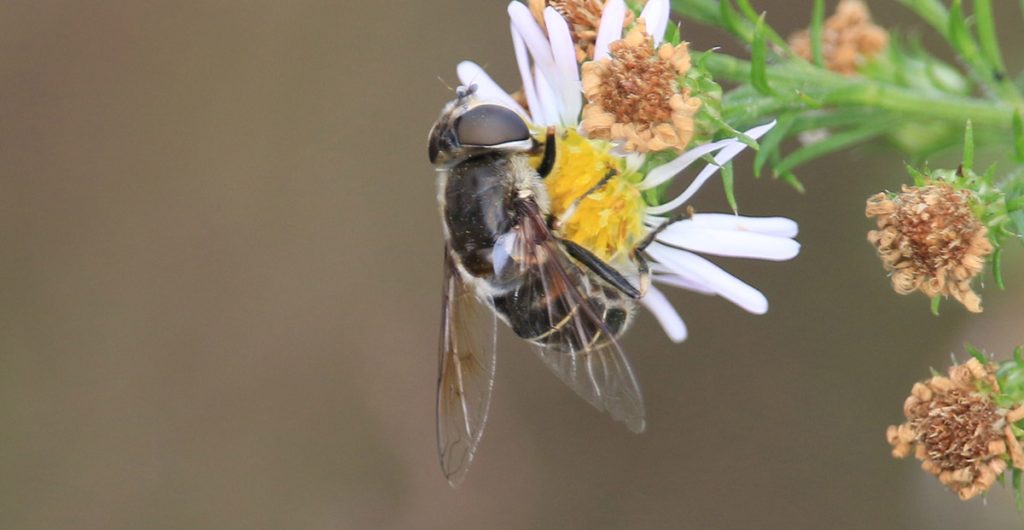
Four-Speckled Hover Fly (Dioprosopa clavata)
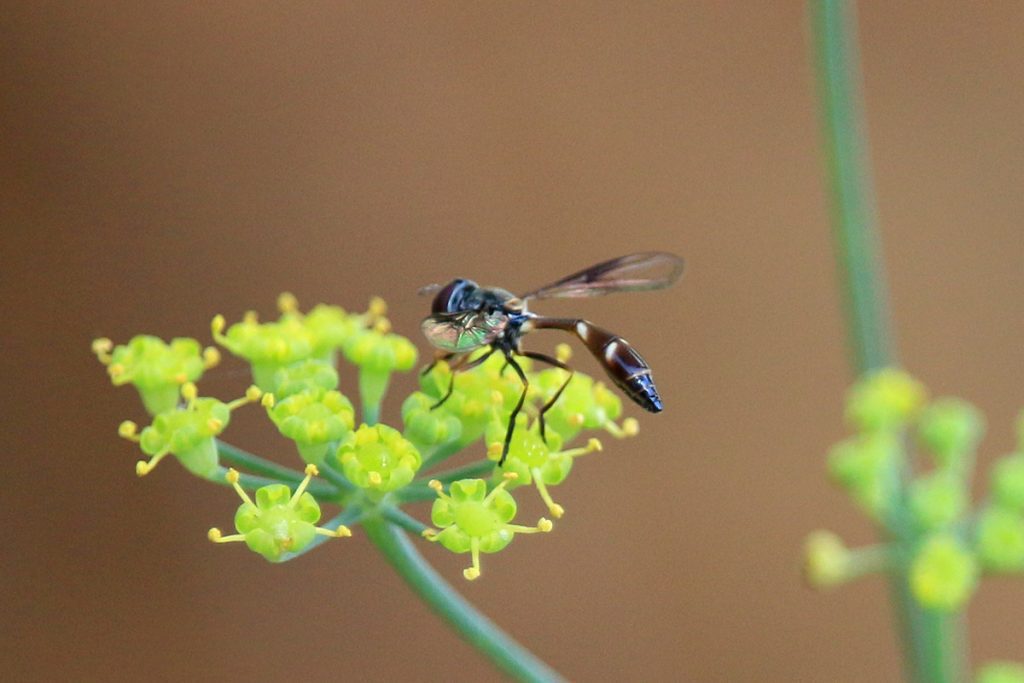
Bee Flies (Bombyliidae)
Here is a second family of flies that mimics the look of bees. Like hoverflies, bee fly adults are pollinators. Their larvae, however, parasitize other insects. As I’ve been learning more about insects in recent years, I’ve been surprised how many insects “grow up” inside of other insects or their nests, eating the young of other species.
Tiger bee fly (Xenox tigrinus)
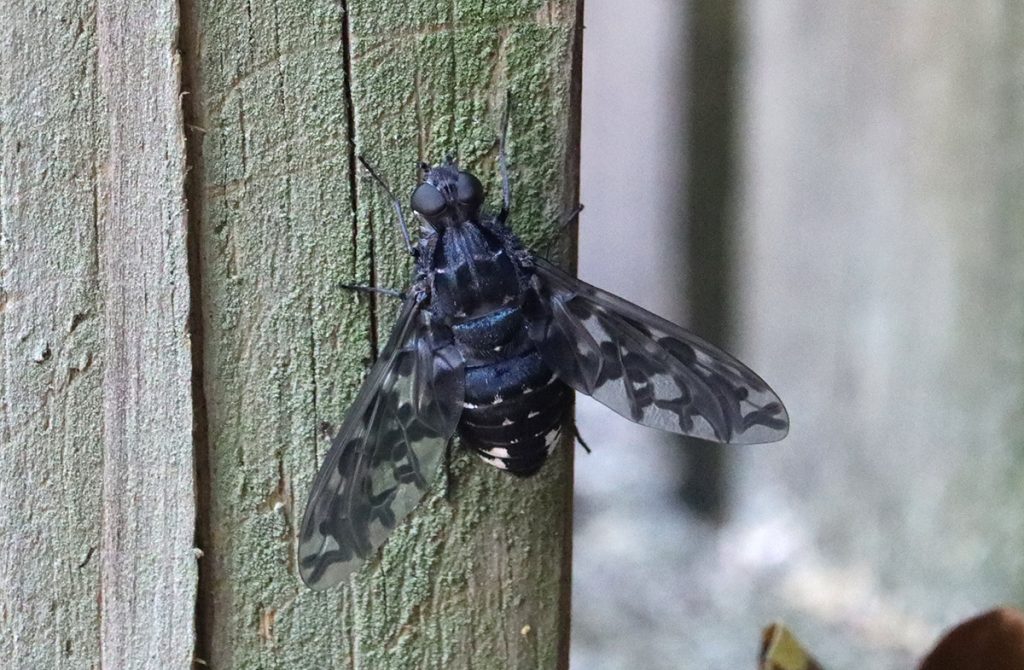
One day (June 1, 2021 if you want to see it on the Backyard Blog) I saw a pollen covered carpenter bee entering a nest in our fence. Some time later, I saw this vicious looking bee fly lurking near the nest. At the time I didn’t know much about bee flies, but I was curious about what was happening here, and I read up on them.
Like many other parasitoid breeders, tiger bee flies have a specific species on which they host- in this case, carpenter bees. Right around the time of day I saw this bee fly, I saw a molted carpenter bee carapace sticking out of the round hole in the fence. At the time, I thought that this was a mother bee fly looking to lay eggs in the nest, but had come too late- the bees had already emerged. Now I wonder if, instead, this tiger bee fly wasn’t the insect that emerged from the carapace.
Villa genus (Banded Bee Flies)
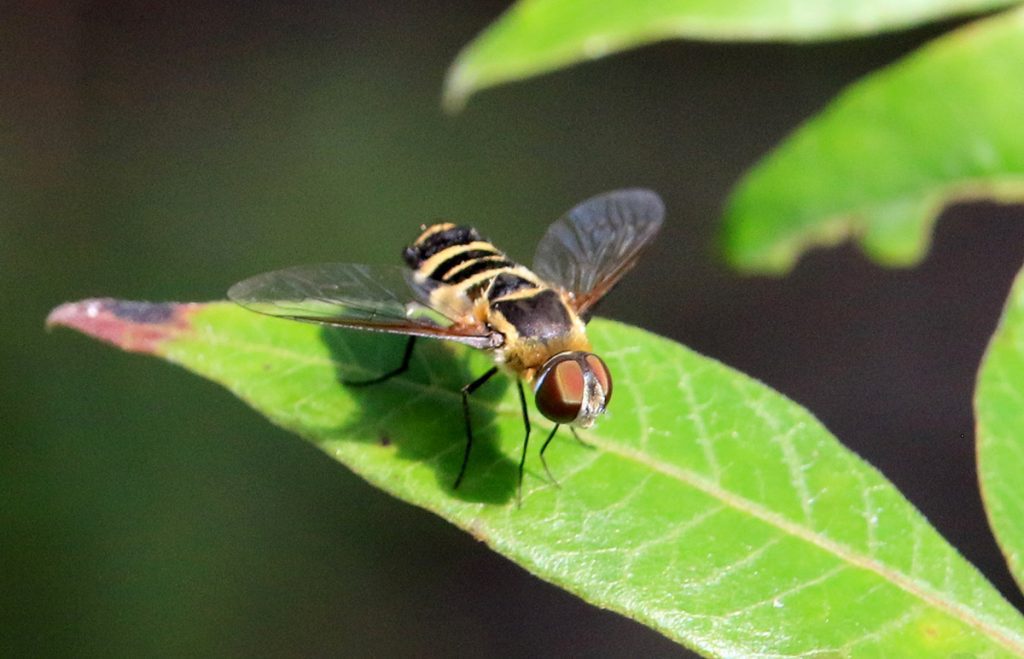
Villa is the closest looking ID for the insect below as well, though no other user came up with an ID more specific than its subfamily.
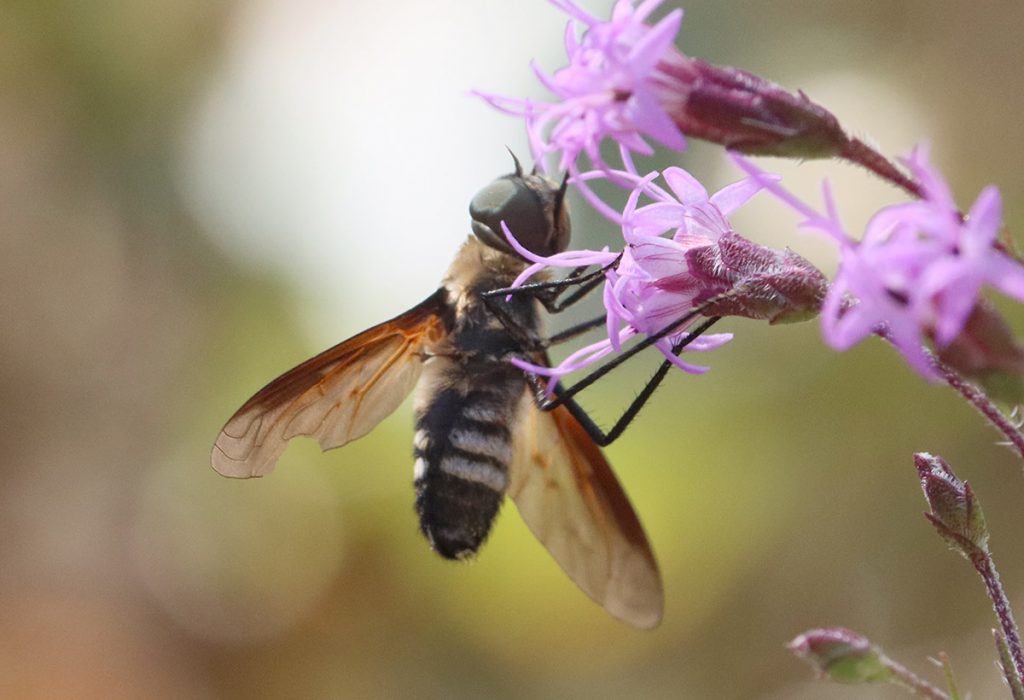
Chrysanthrax cypris

Chrysanthrax cypris a banded bee fly from another genus. As a parasitoid breeder, it specializes in tiphiid wasps (tiphiid wasps are also parasitoid breeders, specializing in beetle larvae in the Scarabaeoidea family).
Genus Poecilognathus
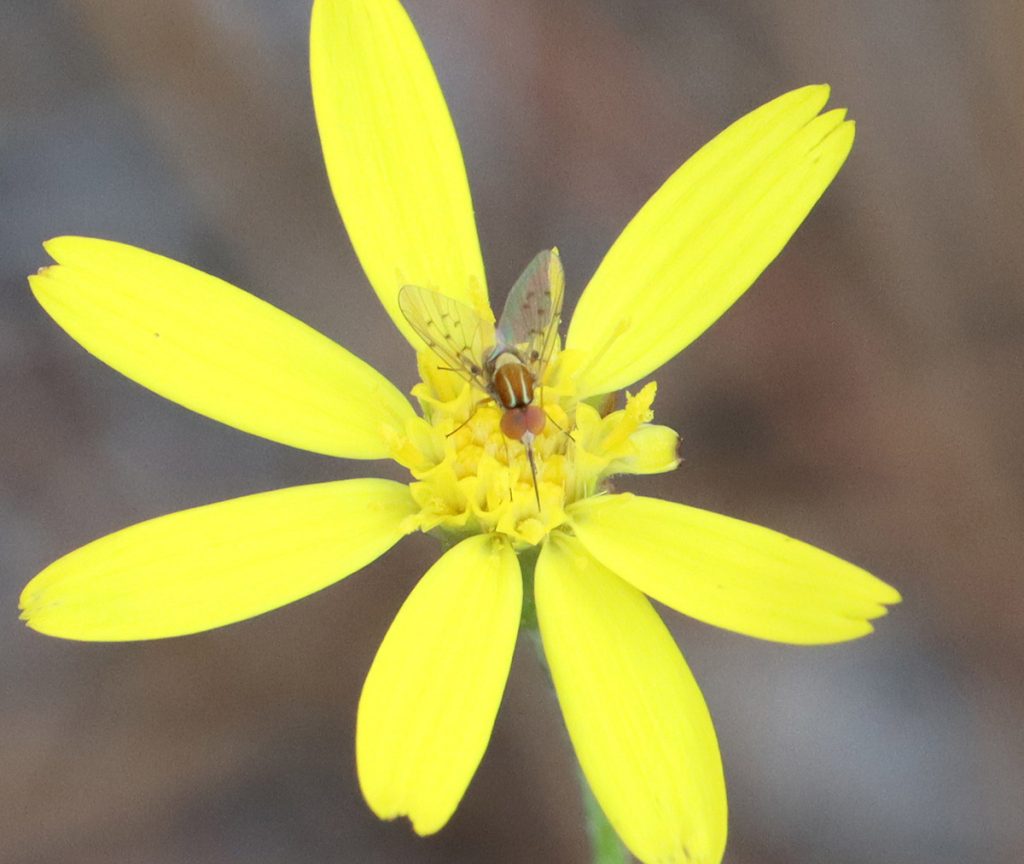
Robber Flies (Asilidae)
Robber flies are, to me, cool looking predators. I like seeing them in the garden, even if I have seen them go after and catch my beloved bees. A well rounded food web has layers and layers of predators and prey. Sometimes the ones we like are the prey.
Hanging Thieves (genus Diogmites)
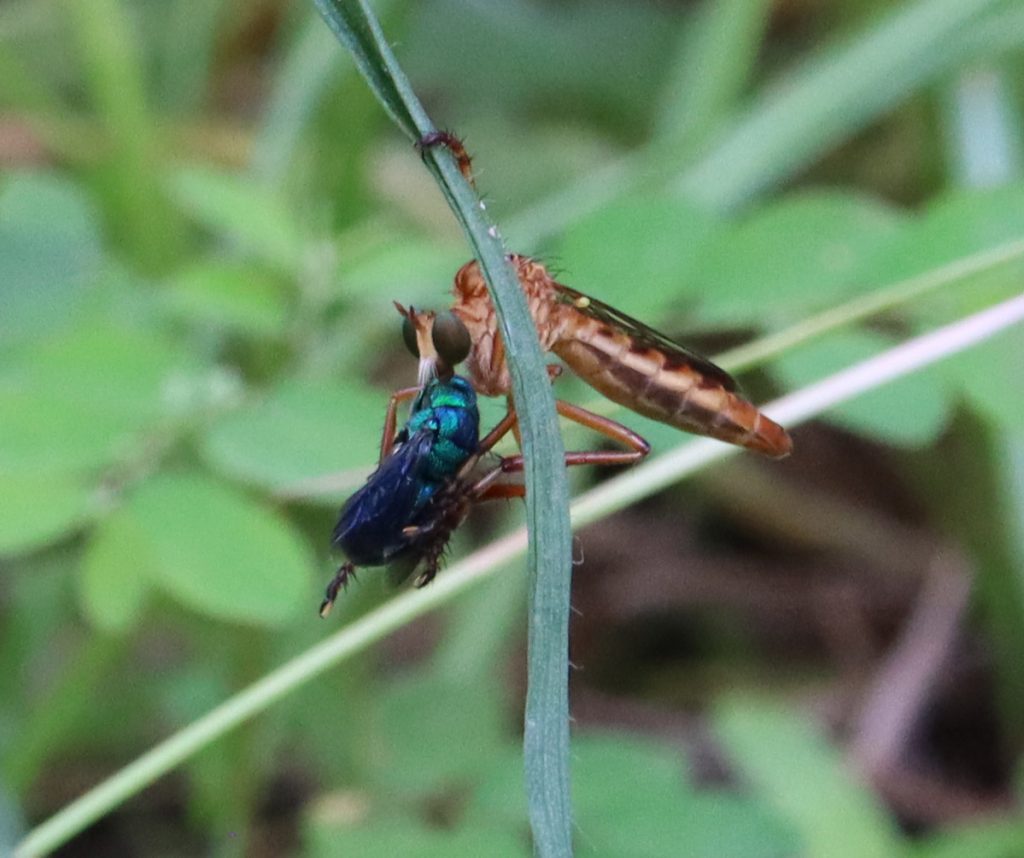
I have better photos of this insect, but this one better shows how it hunts. Hanging thieves hold on under leaves, lying in wait for a passing insect, which they grab with their other legs.
Plumetops (genus Ommatius)
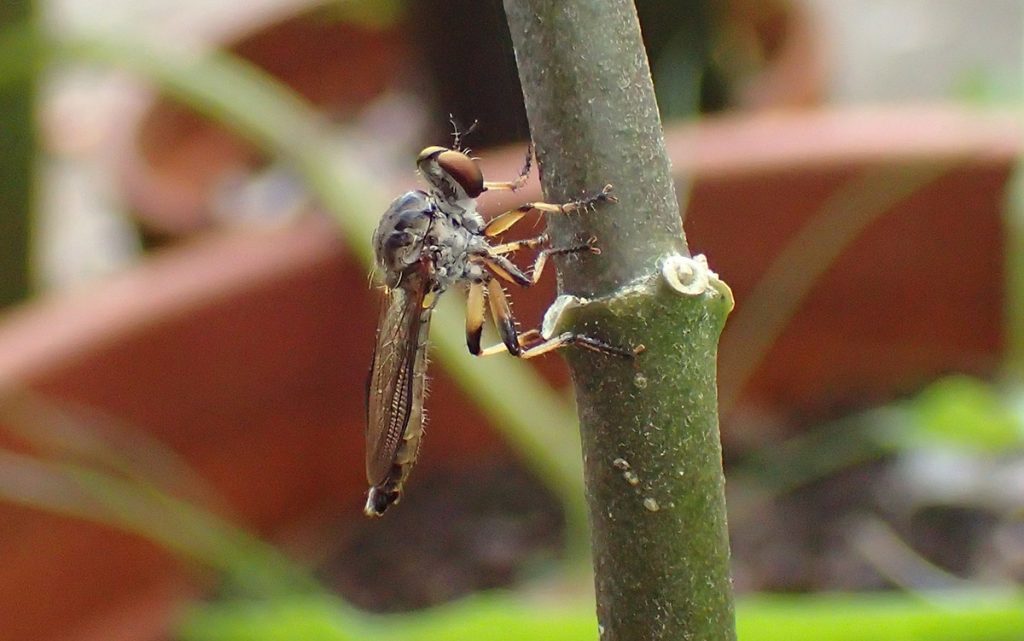
Bee-mimic robber flies (genus Laphria)
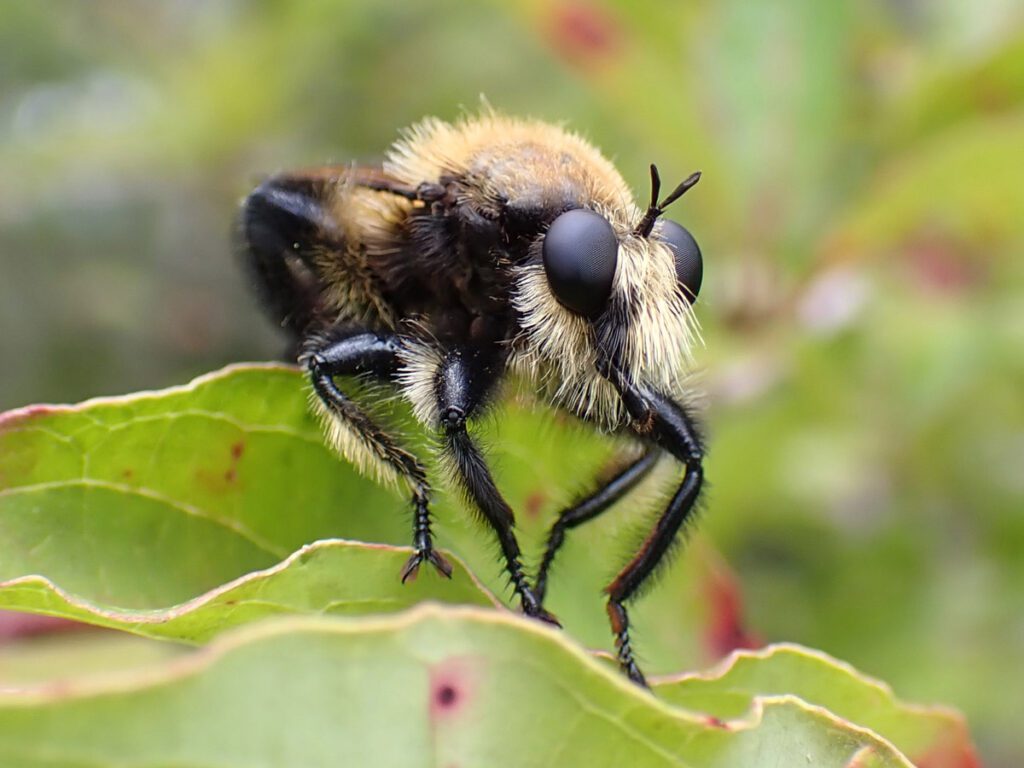
Yes, it’s another group of flies mimicking the look of bees! Each receives a different advantage from their deception. Hoverflies are small and lack the means to defend themselves from other insects. And yet, they look like stinging insects. Bee flies break into bee nests and replace bee eggs with their own, which hatch and eat the pollen gathered by the mother bee.
Robber flies eat bees and other flying insects, including other robber flies. To any insect flying through a flower patch, bee-mimic robbers look like any other pollinator.
iNaturalist lists observations for eleven species of bee-mimic robber flies in Florida.
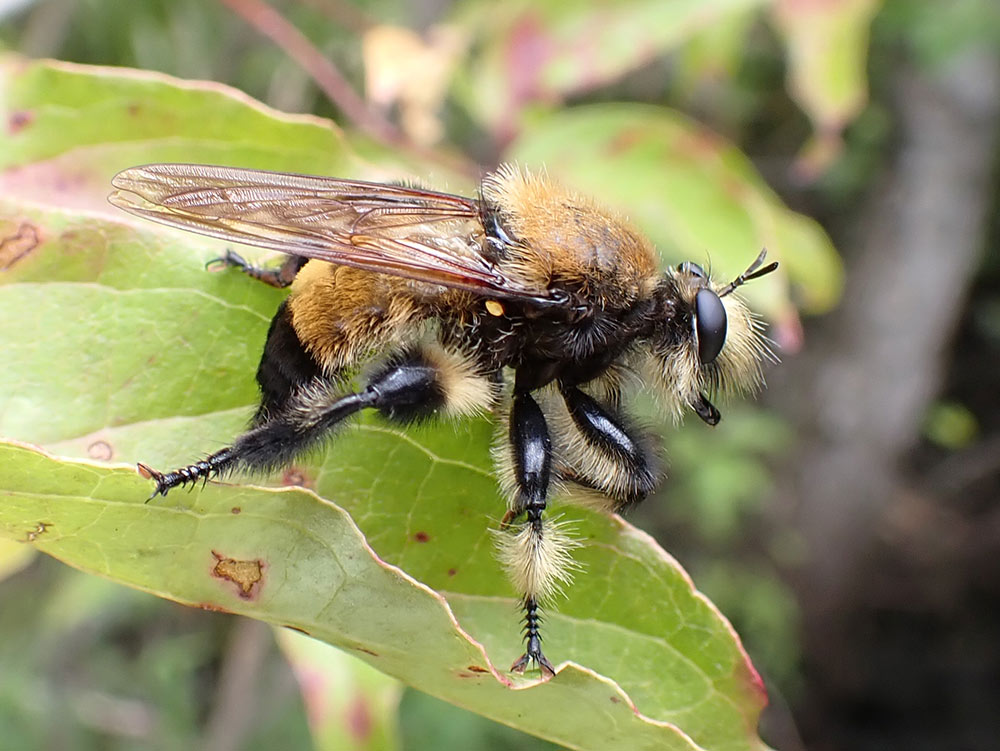
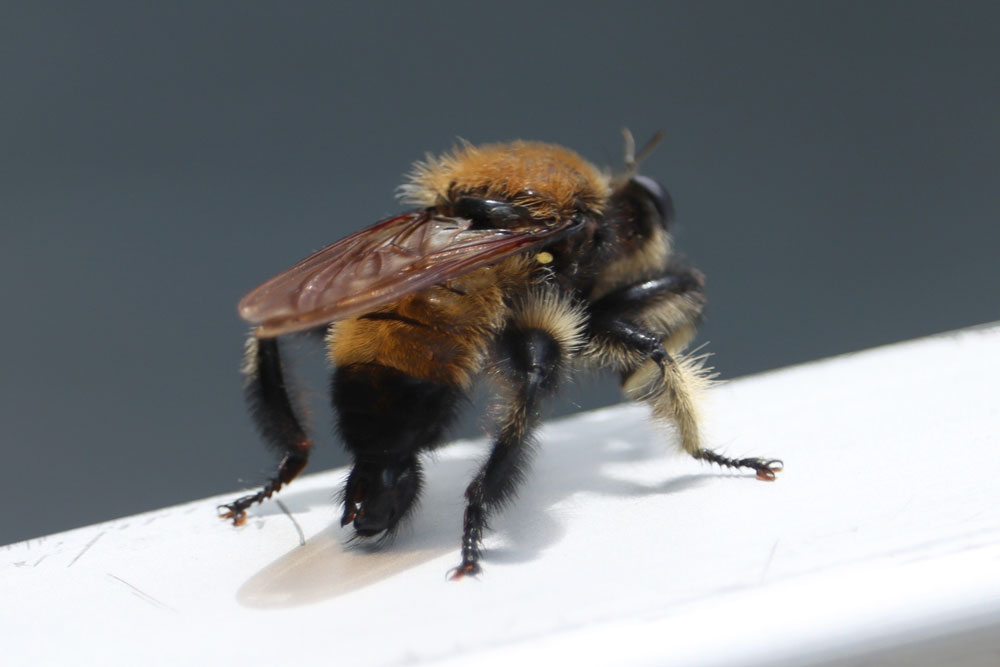
Soldier Flies (Stratiomyidae)
Soldier fly larvae are typically found in decaying plant matter, which they eat. They aid in the decomposition process, helping to build soil.
Black soldier fly (Hermetia illucens)
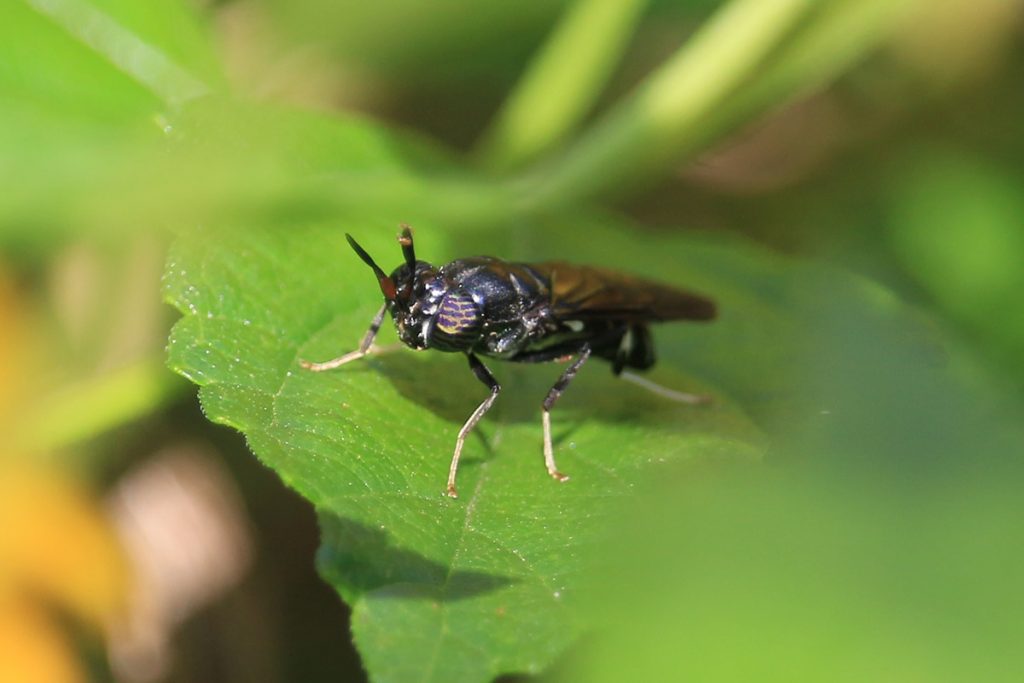
This is the best known and most welcome of the soldier flies. During the warmer months, you may see these flies hanging out near your compost pile. Their larvae consume your rotting fruits and veggies, pooping out compost.
Here they are in action:
Hoplitimyia mutabilis
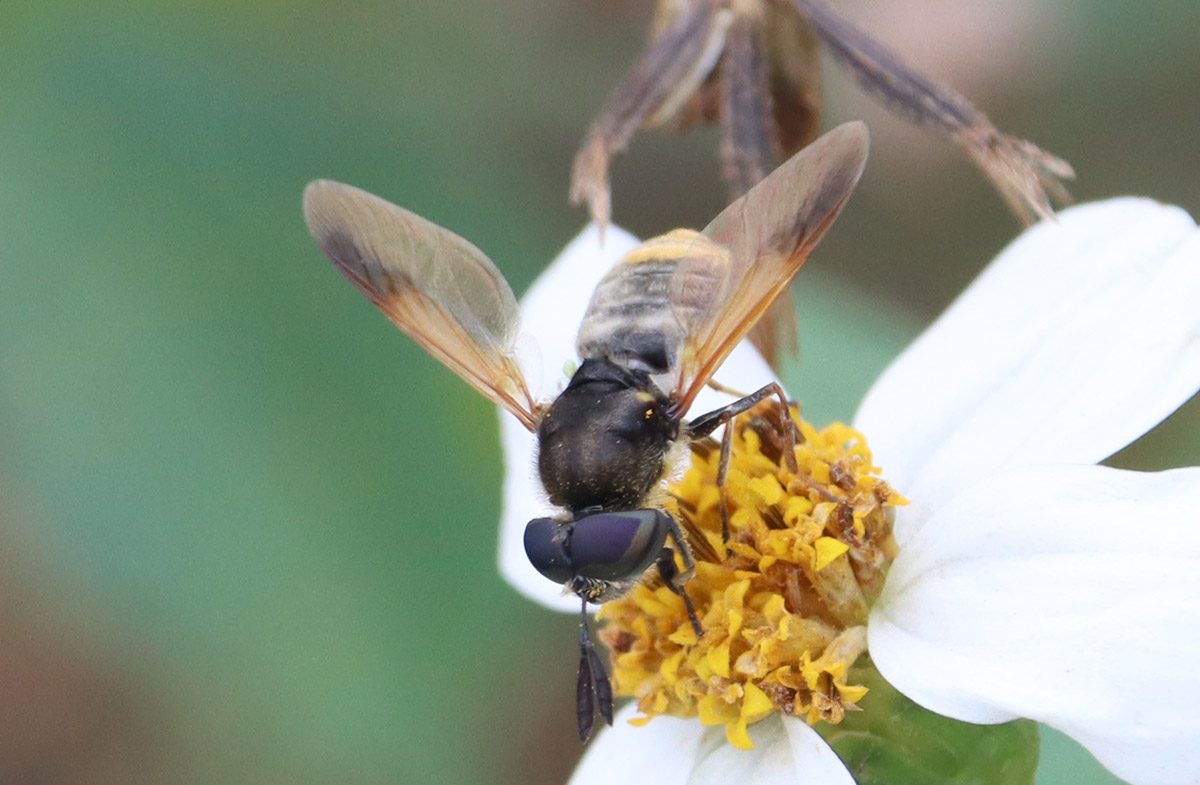
Merosargus caeruleifrons
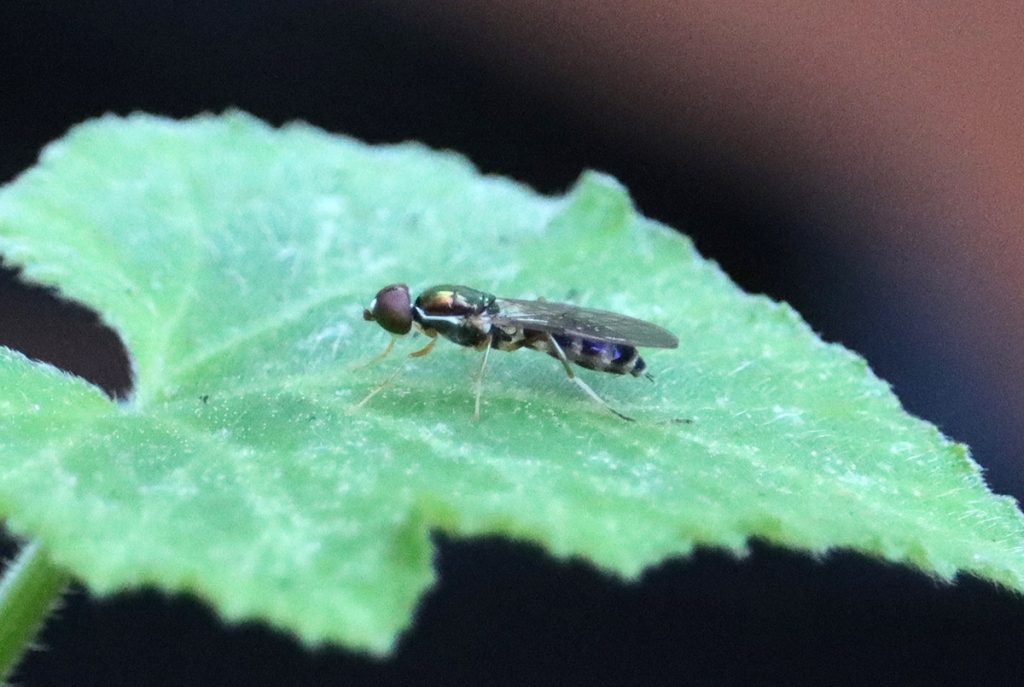
Sargus fasciatus
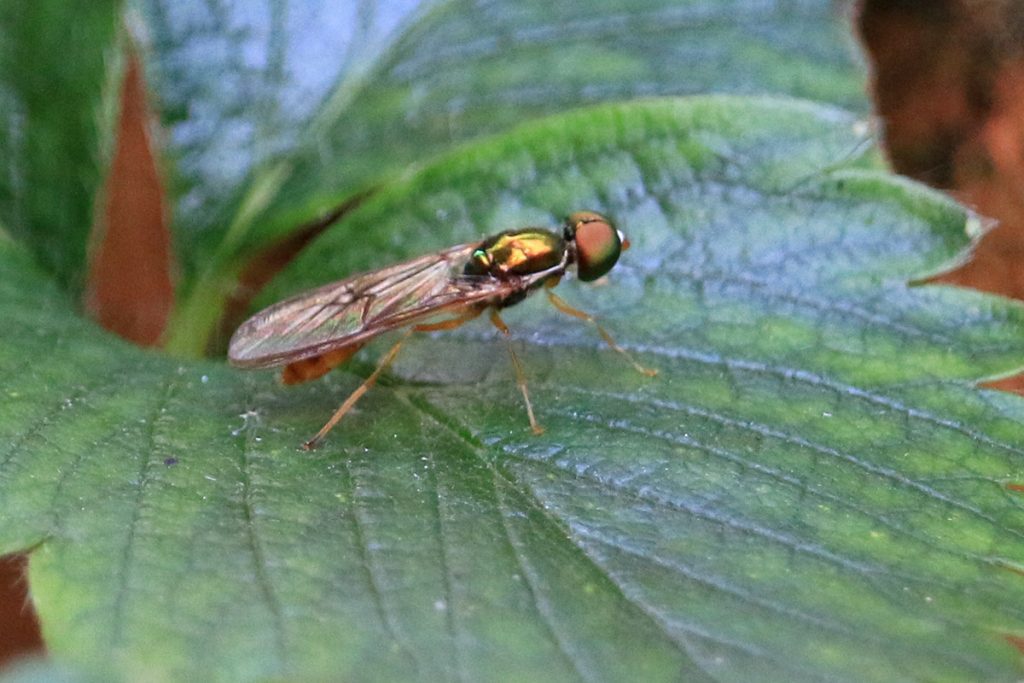
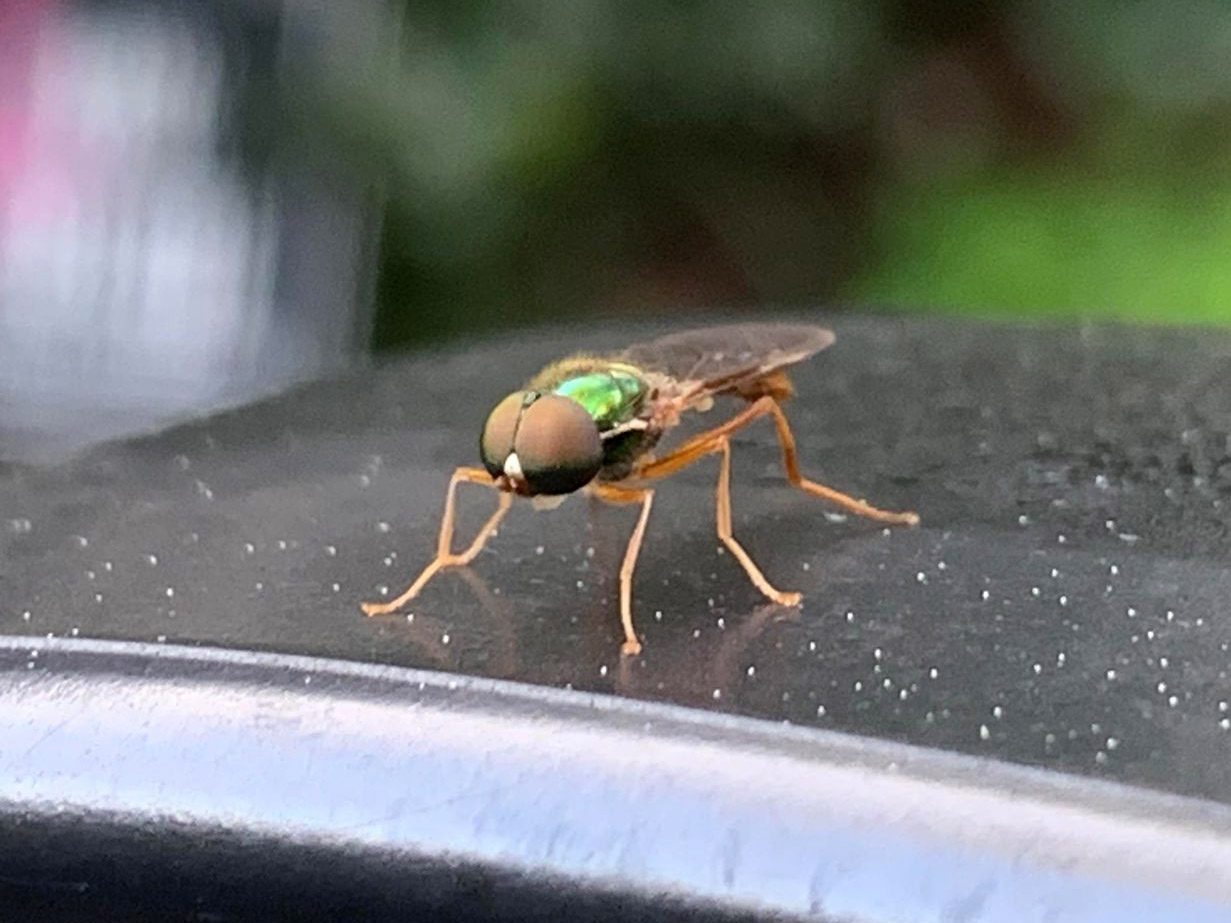
Long-Legged Flies (Dolichopodidae)
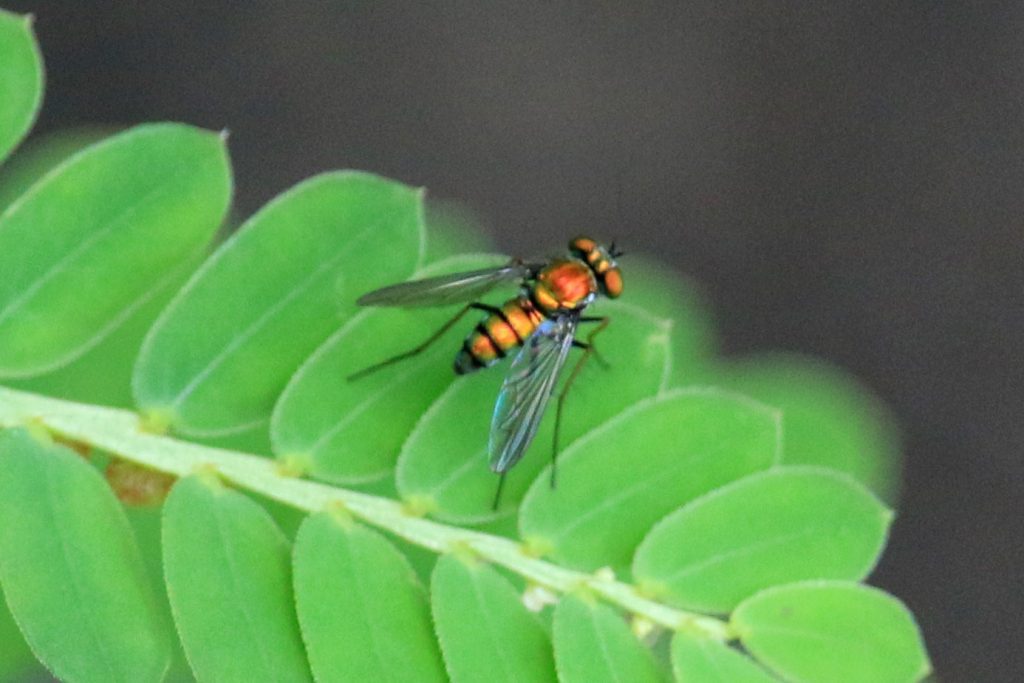
I’ve seen quite a few long-legged flies of different colors around the yard. I rarely get an iNaturalist ID more specific than the genus Condylostylus. These shiny metallic flies are hunters, with many species going after aphids.

Thick-headed flies (Conopidae)
Thick-headed flies are parasitoid breeder, typically inserting their larvae into living insects, which the larvae then devour.
Physocephala sagittaria

This genus of thick-headed flies is known to parasitize bees, in particular bumblebees. The female will tackle a bumblebee while in flight and tear open its abdomen to insert her eggs.
Stilt-Legged Flies (Micropezidae)
Some stilt-legged fly species eat decomposing fruit or dung, while others are predators. I haven’t found species-specific information for every species I’ve identified- more incentive to keep observing!
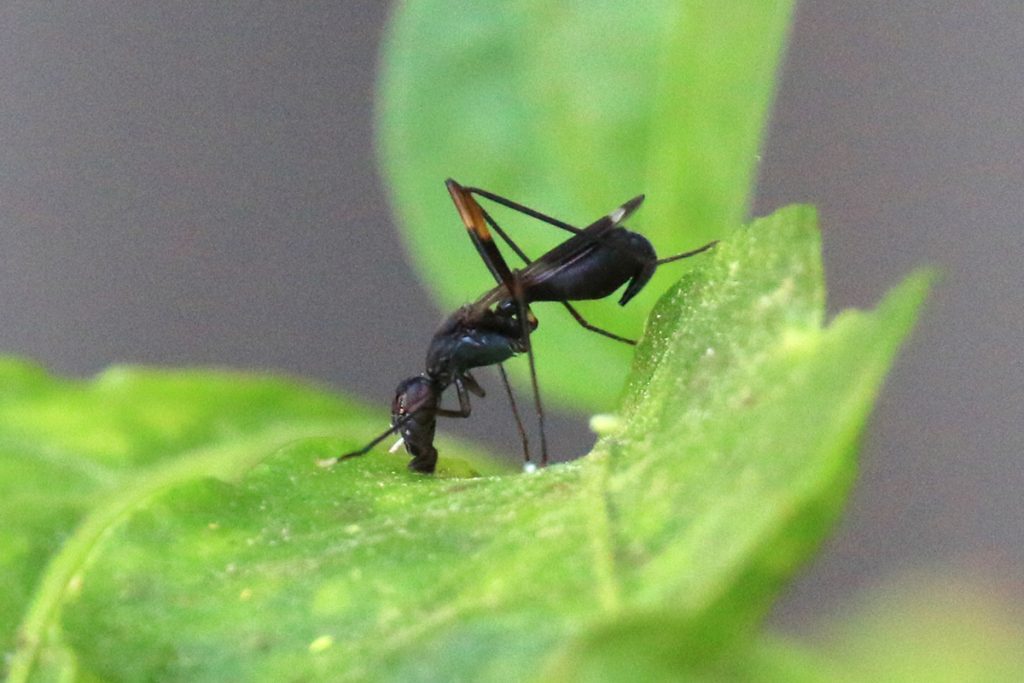
Rainieria antennaepes
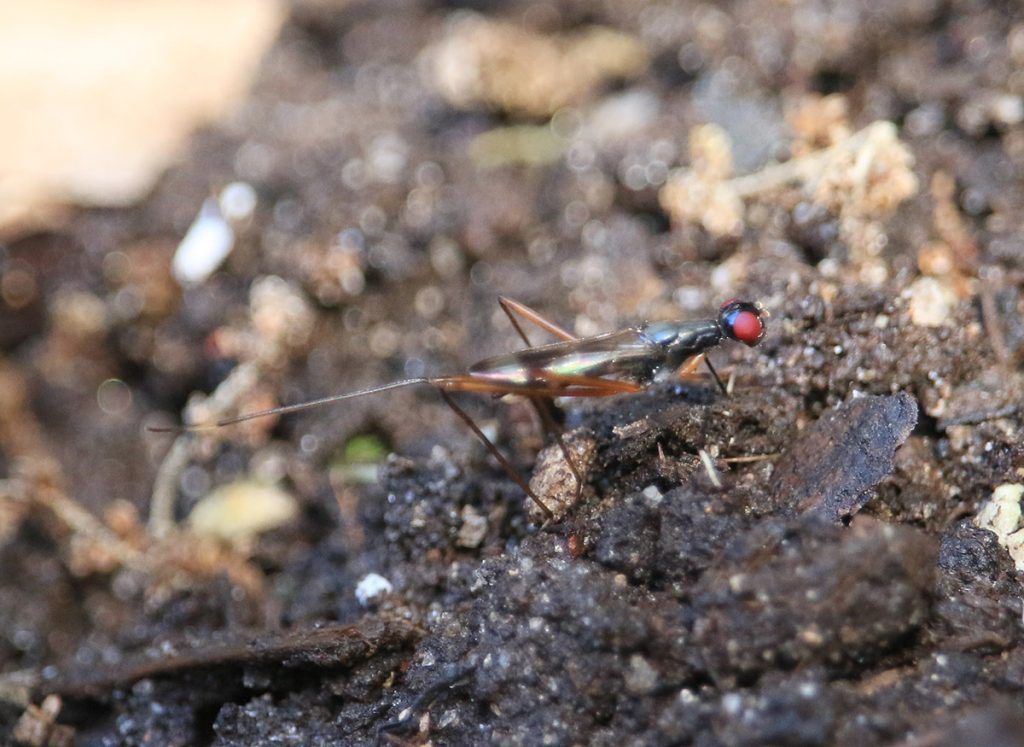
These are detritivores, helping to break down plant matter in the yard space.
Bristle Flies, aka Tachinid Flies (Tachinidae)
Here is another family of parasitoid breeders, though from what I read, they don’t usually have a specific host species.
Trichopoda lanipes
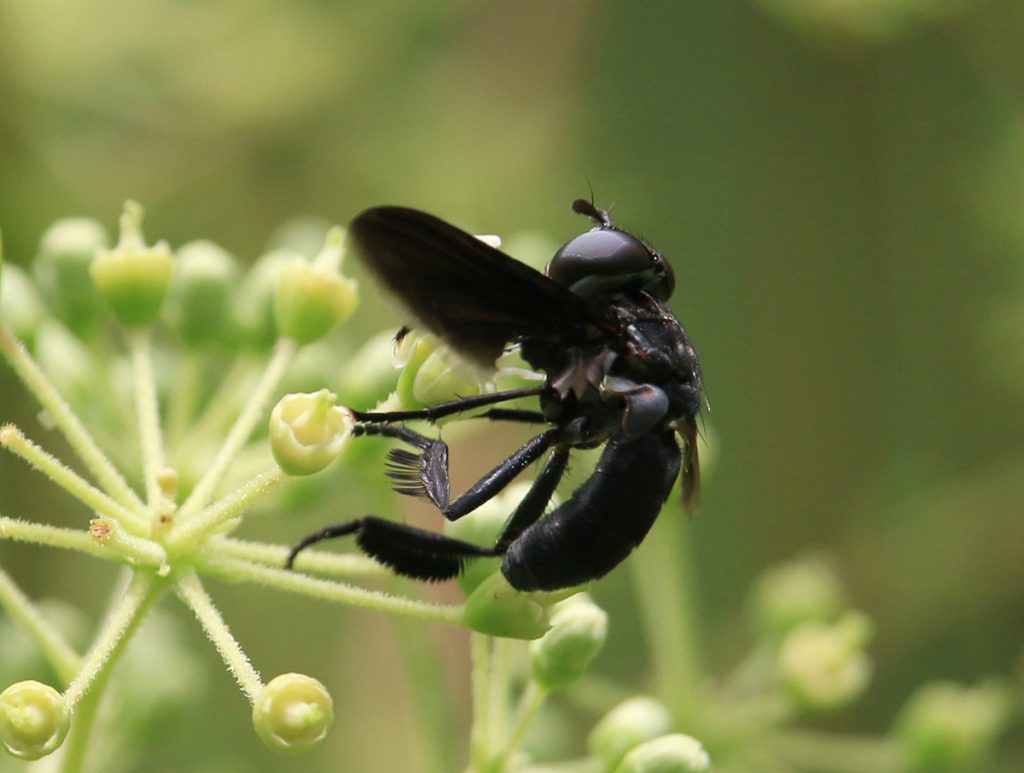
I think this is one of the coolest looking flies I have ever seen. Here’s another look:
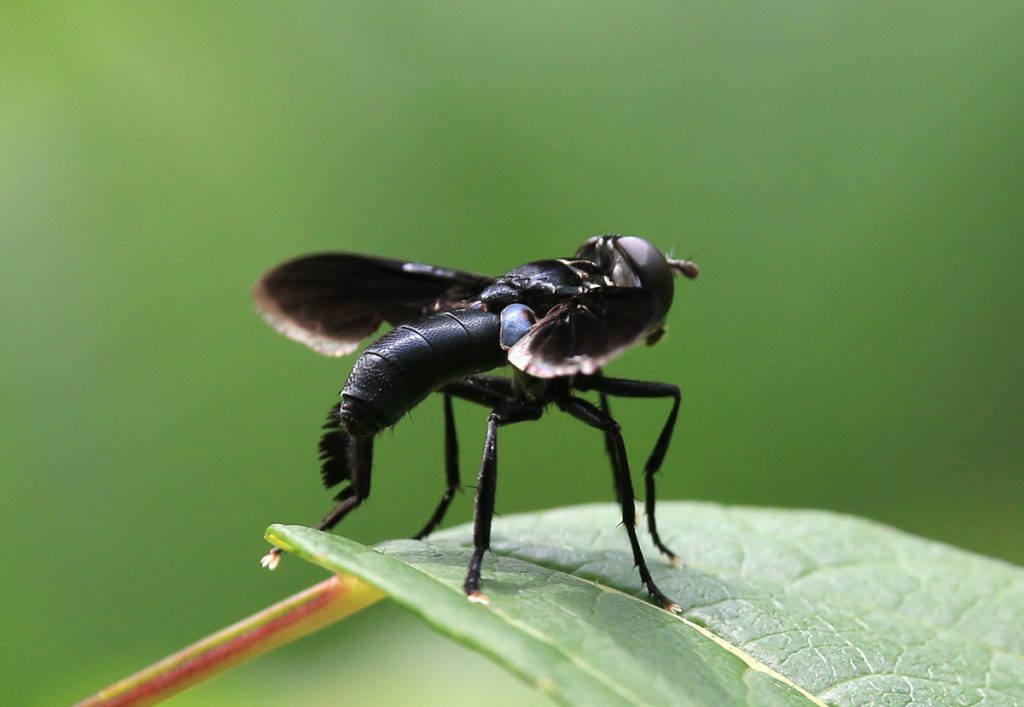
Genus Archytas
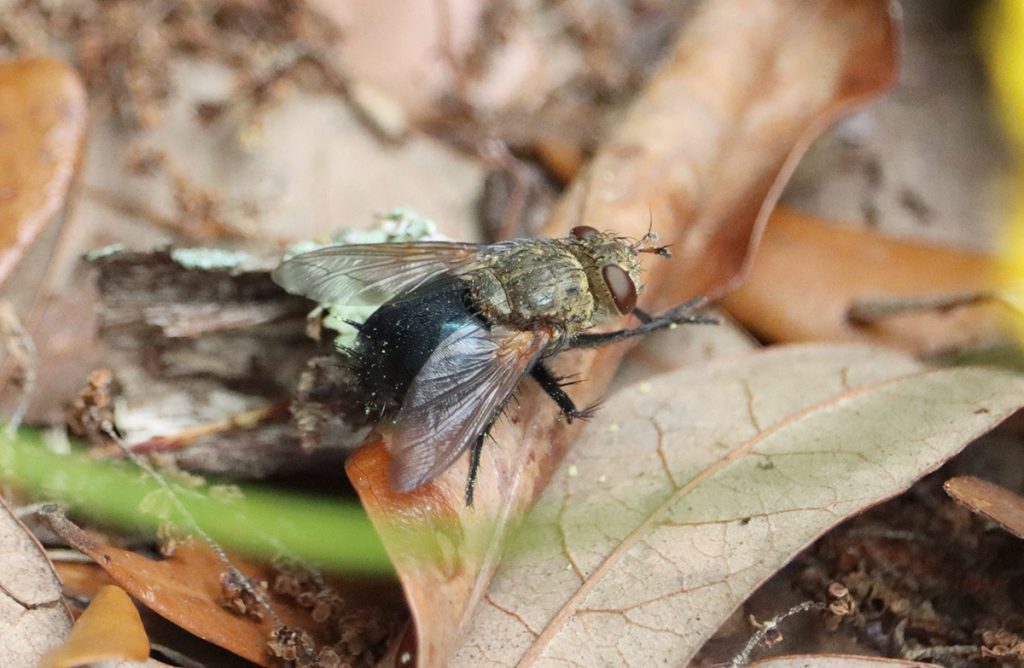
The bristle fly above this one (Trichopoda lanipes) looks so sleek and elegant. This one is beautiful in its own way. According to BugGuide, Archytas hosts on moths.
Euantha litturata
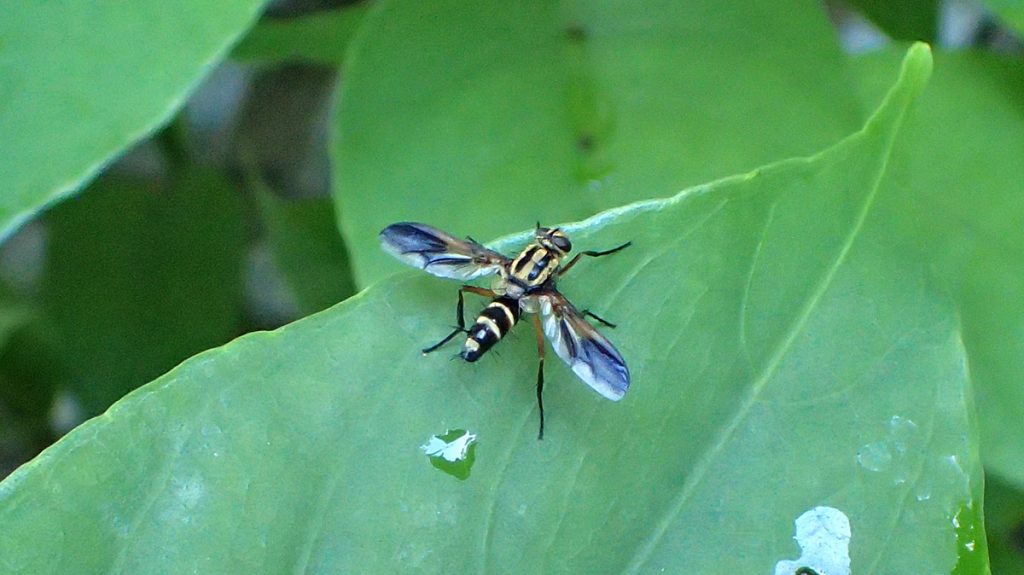
Mydas flies (Mydidae)
Nemomydas jonesii
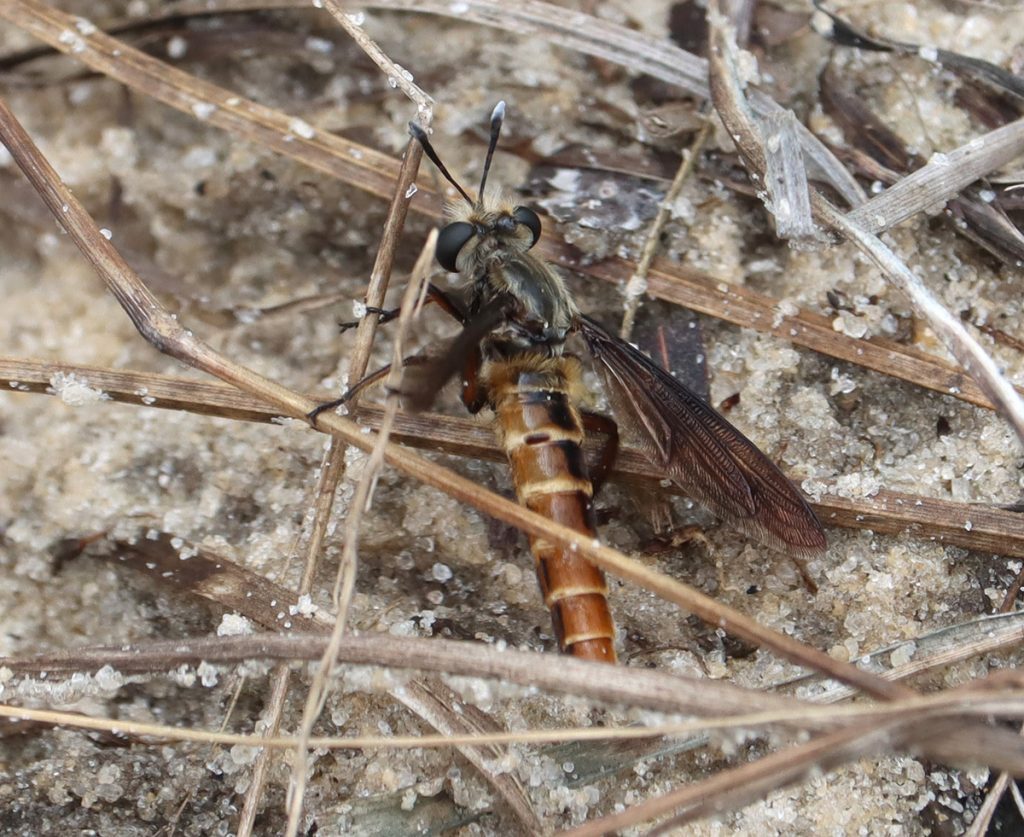
Flesh Flies (Family Sarcophagidae)
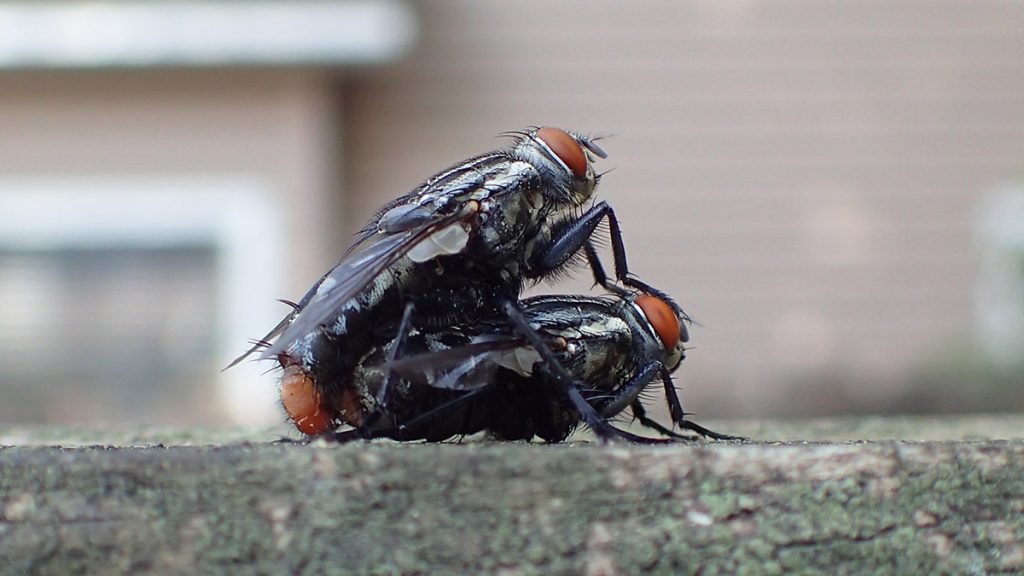
Another species iNaturalist users couldn’t pin down. Flesh flies eat dung, open wounds, or decomposing mammal flesh. This photograph was taken when we still had a dog. I have no strong desire to see these insects in the yard again, but I do miss dung beetles.
Horse and Deer Flies (Family Tabanidae)
Tabanus gladiator, a horse fly
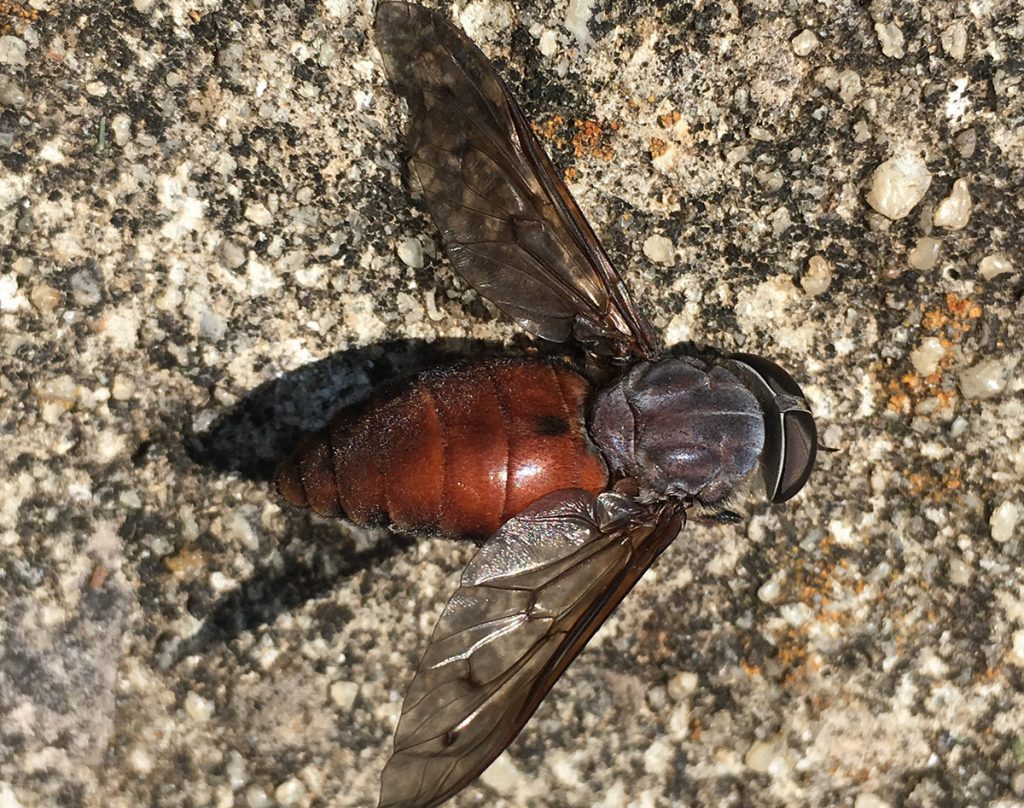
Lauxaniid Flies (Family Lauxaniidae)
Neogriphoneura sordida
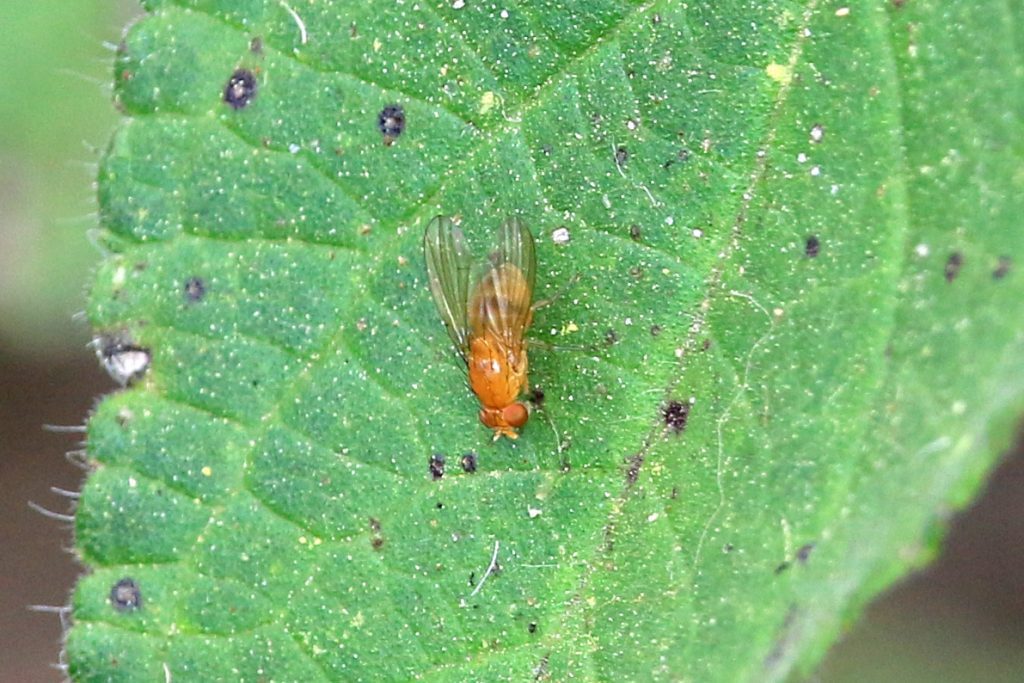
Lauxaniid flies eat leaf litter, so this is another helpful decomposer.
Blow Flies (Family Calliphoridae)
Oriental latrine fly (Chrysomya megacephala)

This is a nonnative known for infesting corpses soon after death. Their larvae feed on feces, meat, and fish. I do often see adults on flowers. When we had a dog, an incentive to pick poop up quickly was that these flies would swarm the poop, and then fly onto our food plants.
Fruit Flies (Family Tephritidae)
Genus Xanthaciura
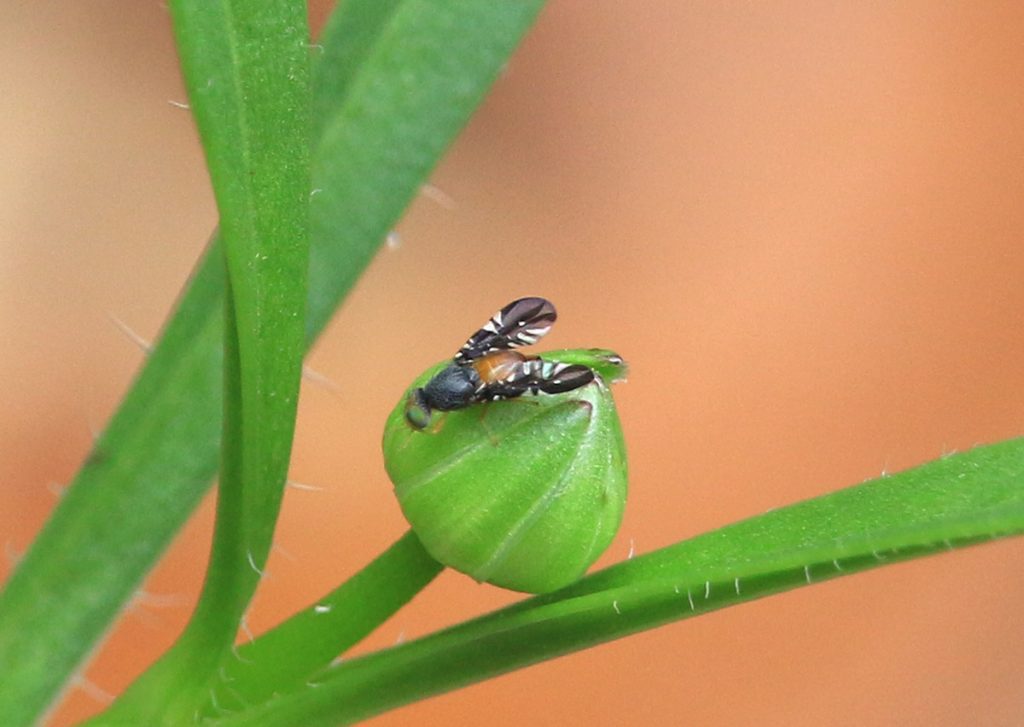
A more colorful insect than we might associate with fruit flies.
Dioxyna picciola
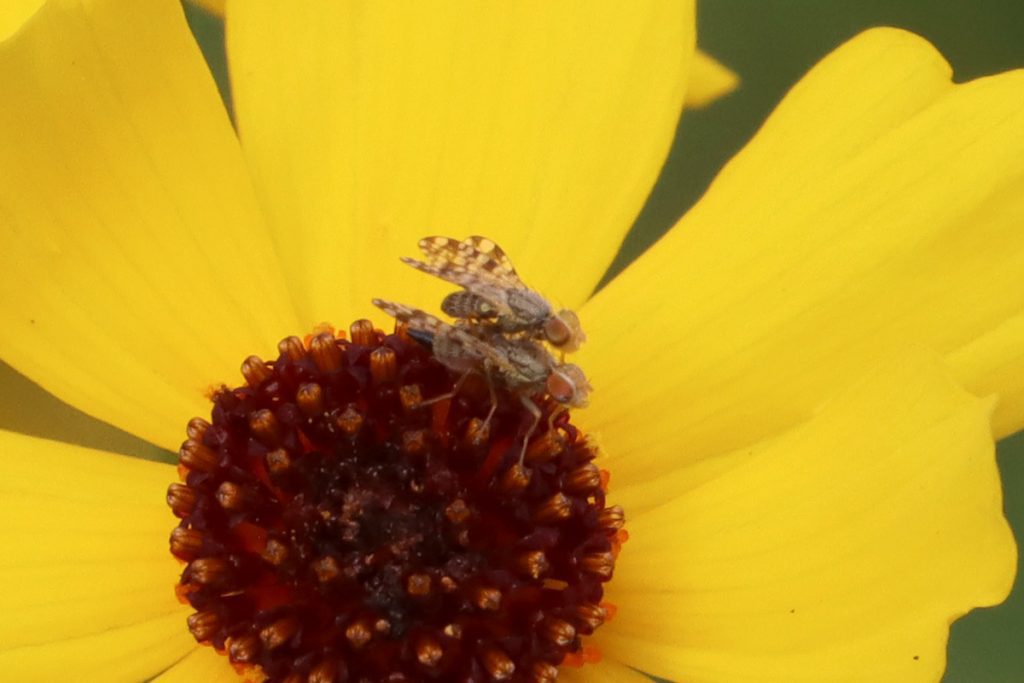
This fruit fly feeds on flowers in the sunflower/ aster family, Astercaea.
Nematoceran Flies
A suborder of flies with mostly aquatic larvae.
Crane Flies (Infraorder Tipulomorpha)
Crane fly larvae break down organic matter by consuming it, in freshwater or semi-aquatic environments.
Nephrotoma wulpiana

Non-Biting Midges (Family Chironomidae)
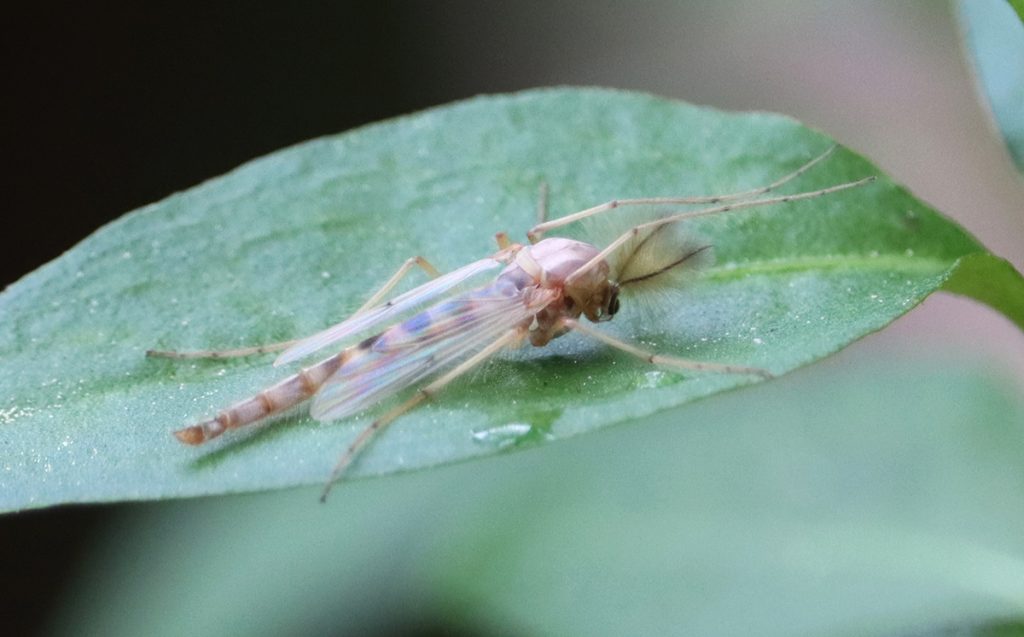
The iNaturalist description says that individual species of this genus can only be told apart by examining their chromosomes. Non-biting midges are decomposers in freshwater or semi-aquatic environments. Semi-aquatic environments can include tree holes or other places where water may stand.
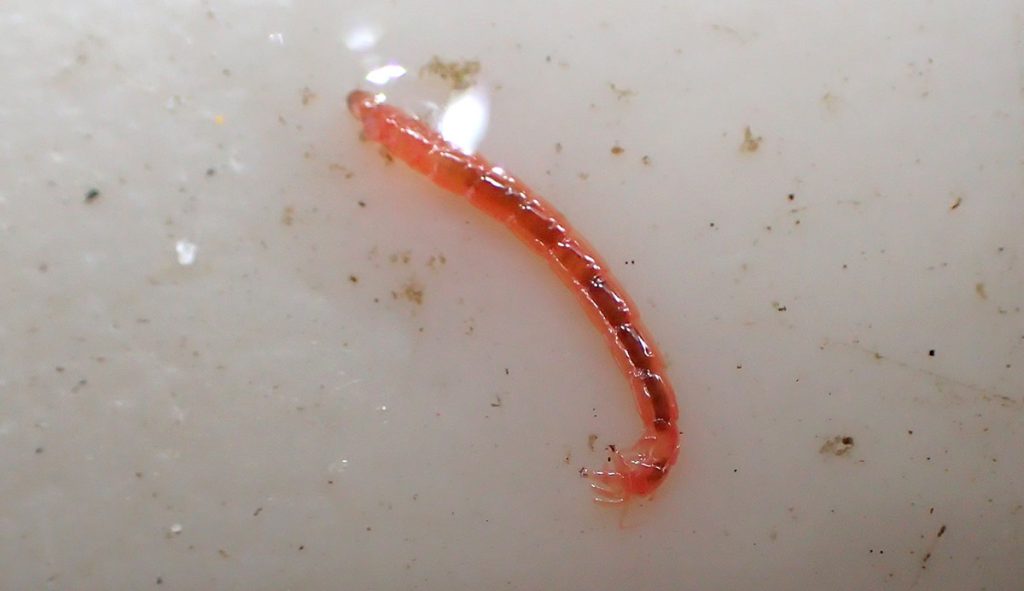
I found this larva while dumping out the bird bath. It had become scummy and I saw mosquito larvae swimming in it. This scummy water, I guess, qualifies as a semi-aquatic environment. iNaturalist suggested Chironomus as the ID. I ID’d two adults in the yard in March and April of 2021; this was found in May of 2021.
Gnats and Allies (Infraorder Bibionomorpha)
I don’t think I’ve ever thought to photograph a mosquito (rather than try and swat it), but this is their group (EDIT 9/12/22- I did photograph a fly that turned out to be a native species of mosquito).
Elephant Mosquito (Toxorhynchites rutilus)
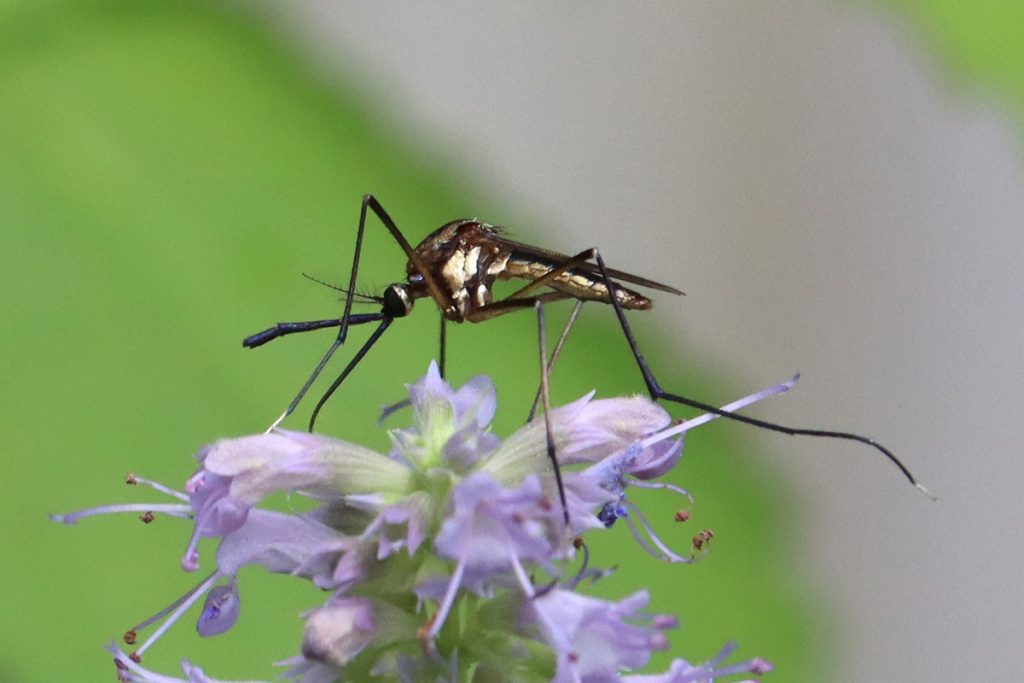
I saw this large fly pollinating my anise hyssop plant. Its shape reminded me of a robber fly of some sort, so imagine my surprise when it turned out to be a native species of mosquito.
Common Lovebug (Plecia nearctica)
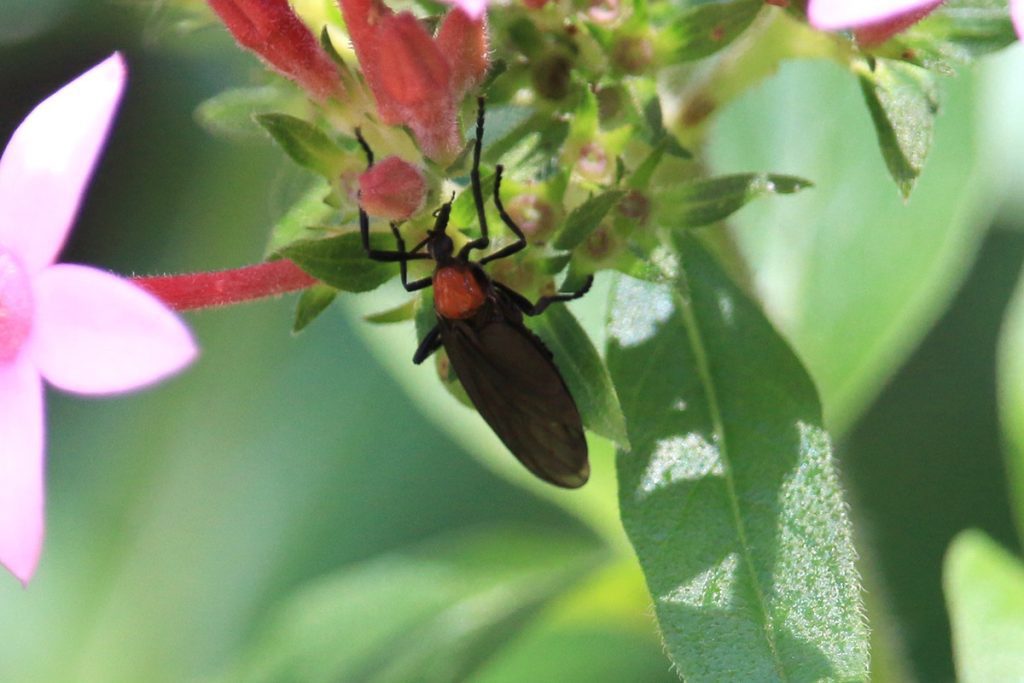
Here’s an insect we see a lot of during their peak flying months. Sometimes we see them in the garden rather than on our windshields. Here’s another species listed as native to the US on iNaturalist, but as also native to most of the hemisphere. Reading the article (iNaturalist’s “About” section is taken from Wikipedia), lovebugs were first found in the US in 1911, spreading from Texas to the rest of the American southeast. Other sources also have lovebugs originating in South American and spreading through the US in the 20th Century.
Polystepha, a gall midge
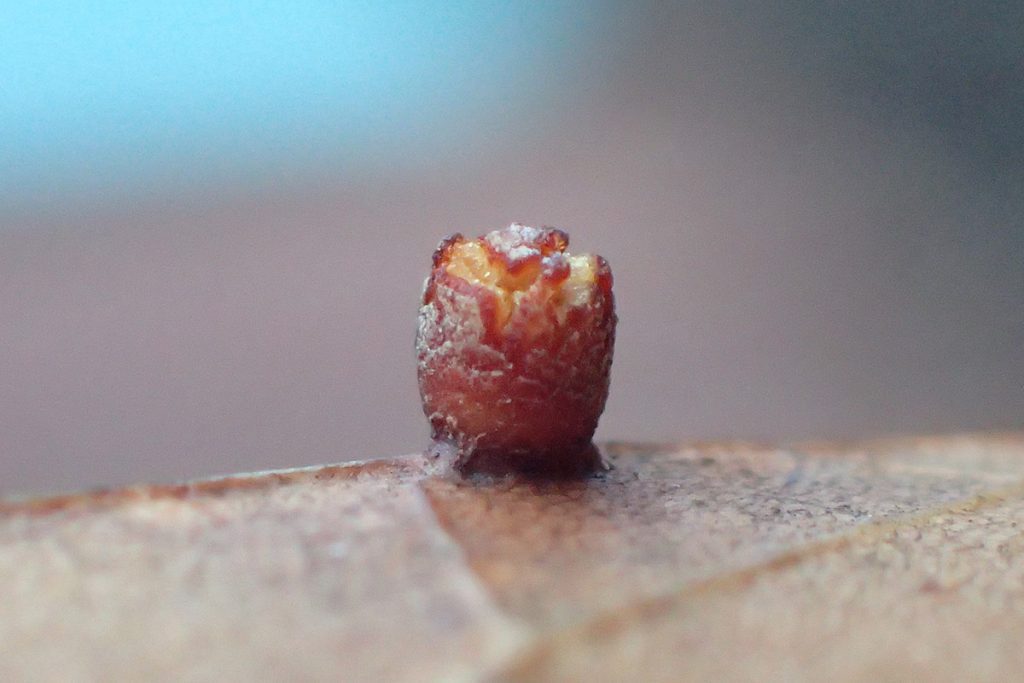
Just as gall wasps inject their eggs into leaves and stems, so do gall midges. Also like gall wasps, a chemical forms a structure in the plant material to house the larvae. Next time you rake leaves, pick up a few and take a look. Between gall wasps and midges, and moths that attach small chrysalids to leaves, there may be more life there than you’d expect.
Dark-winged fungus gnat (Family Sciaridae)
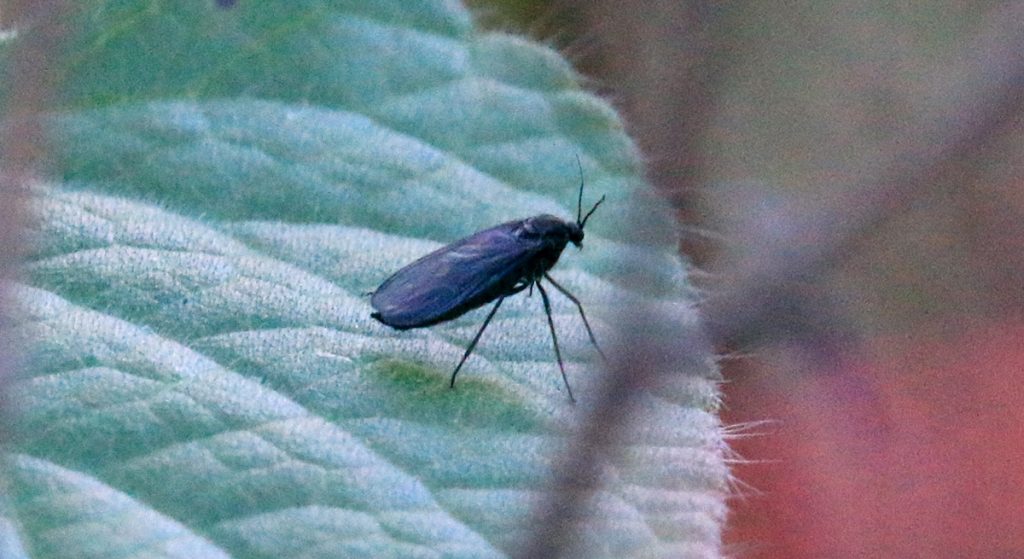
Sometimes iNaturalist can only give us a general identification. This is common with groups of smaller insects, and I do read on its page that it’s not a well studied family. It says they are pests in mushroom farms and found in household plant pots.
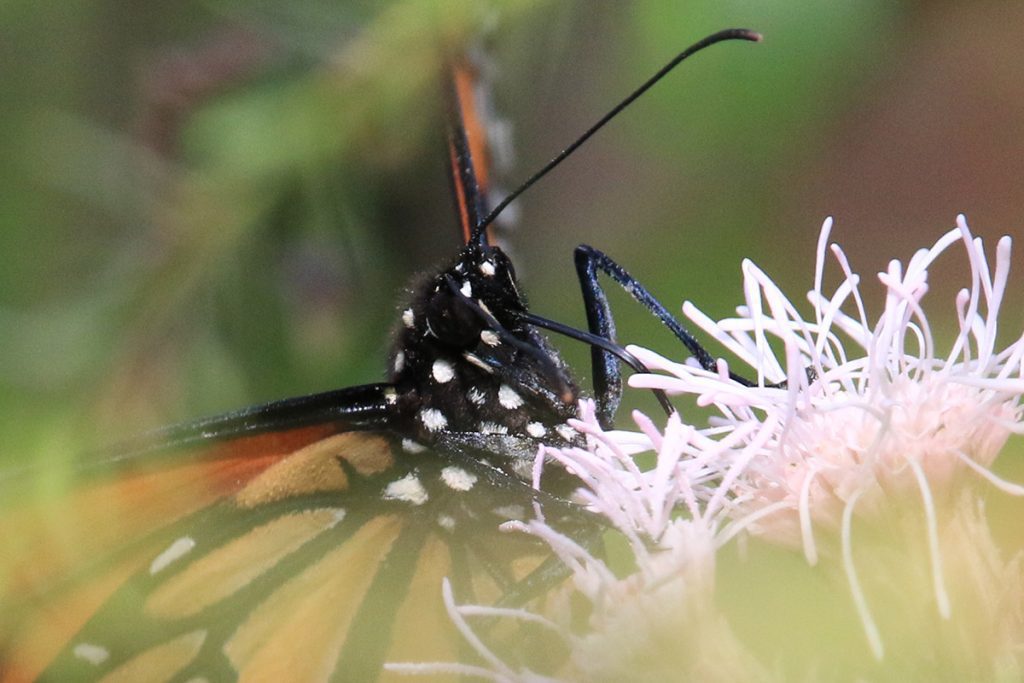
Dig Deeper into Backyard Ecology
What can we do to invite butterflies, birds, and other wildlife into our yards? And what about the flora and fauna that makes its way into our yards; the weeds, insects, and other critters that create the home ecosystem? WFSU Ecology Blog takes a closer look.
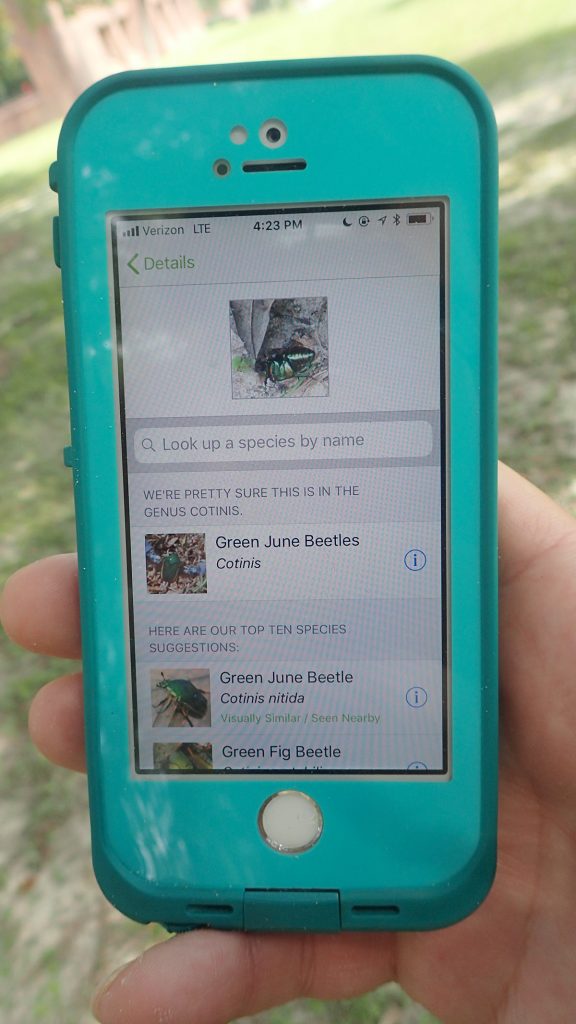
Apps and Citizen Science mentioned in the Backyard Blog
iNaturalist
Identify plants, animals, lichens, and fungi in your yard. Other users correct your identifications if you’re wrong, and even if they don’t, it can be a good springboard to further research.
Seek by iNaturalist
Instant identification, and it doesn’t record your location. This is a good option for kids with phones.
Monarch Larva Monitoring Project
Enter information about monarch caterpillars in your yard, and help researchers get a sense of the health of the monarch population that year, and how and when they’re migrating.
Great Sunflower Project
Record the number of pollinators visiting your flowers, and help researchers map pollinator activity across the country.

